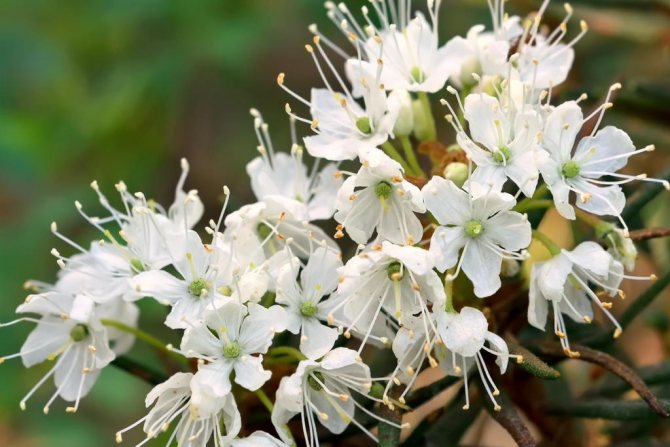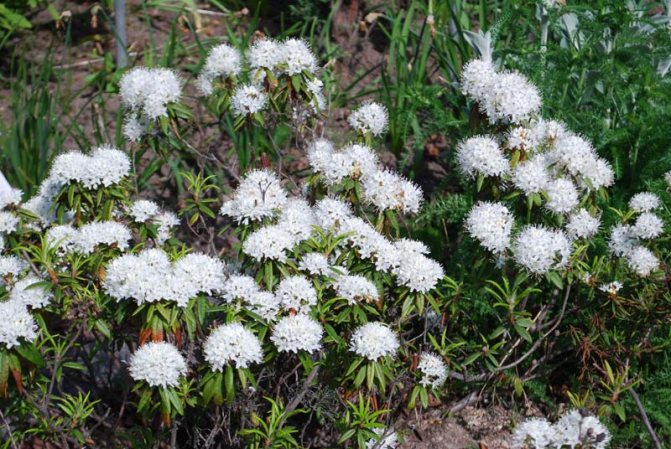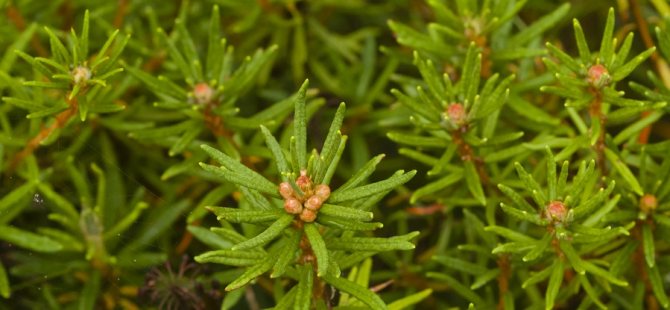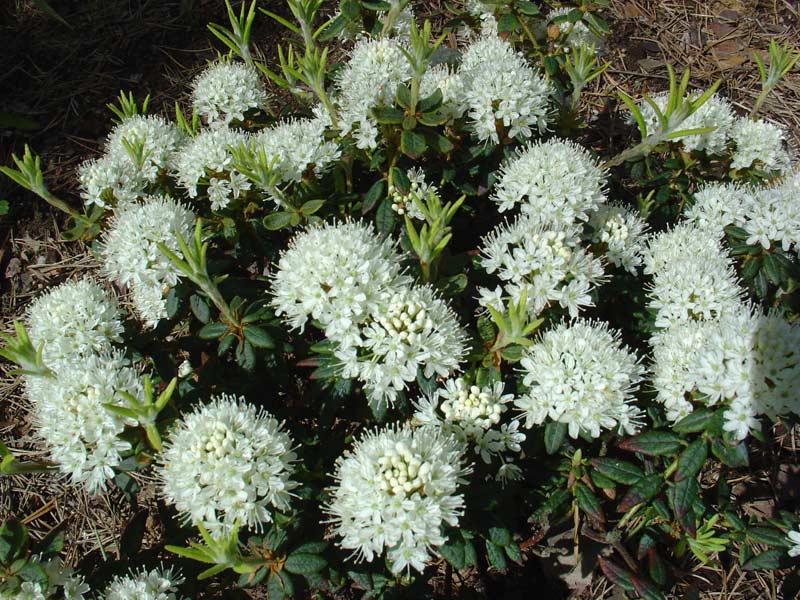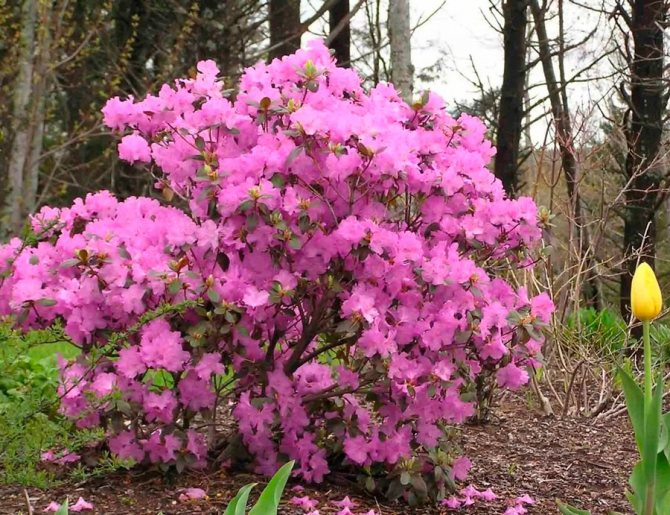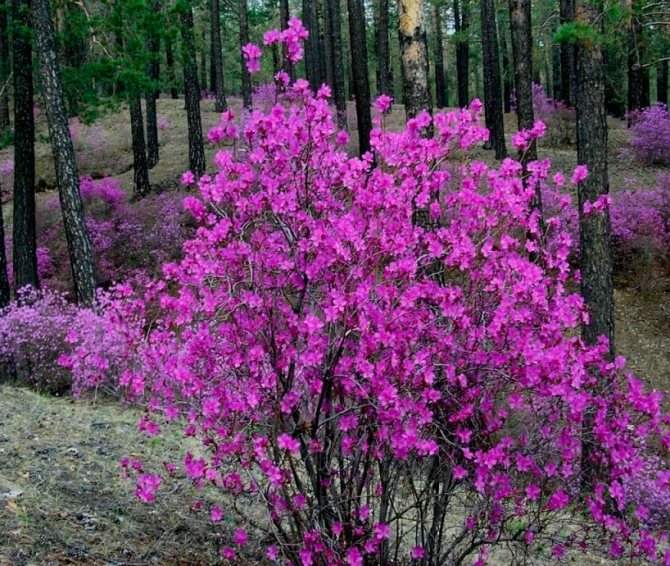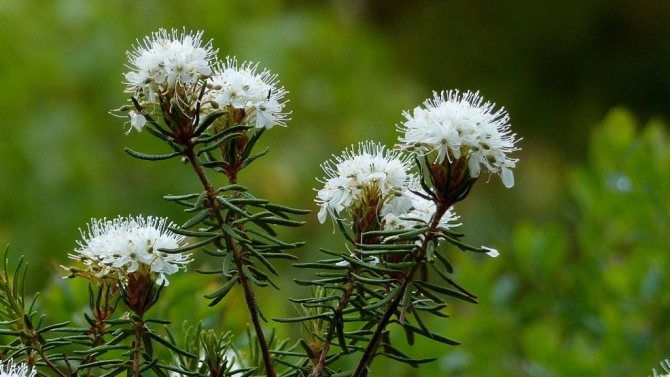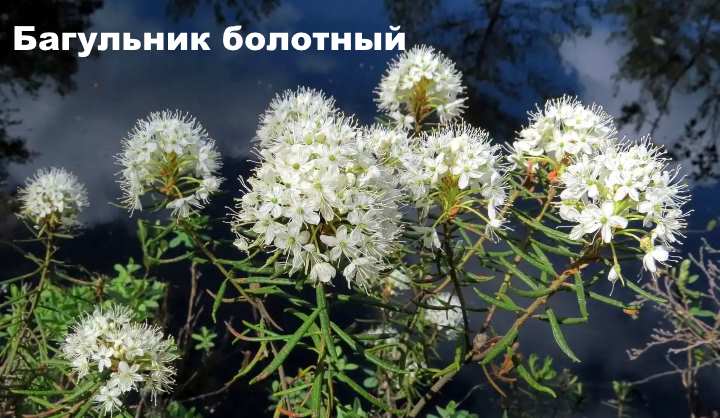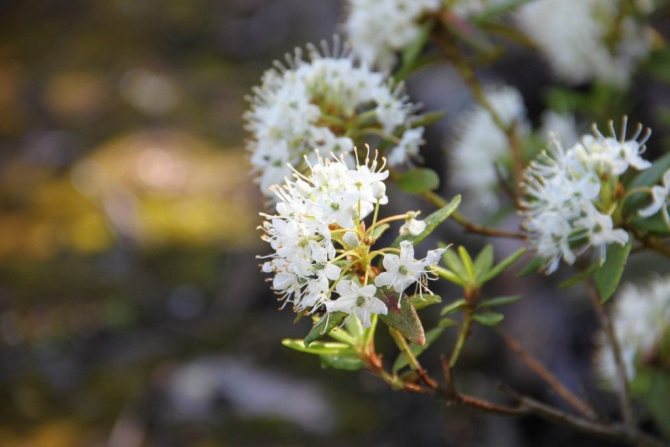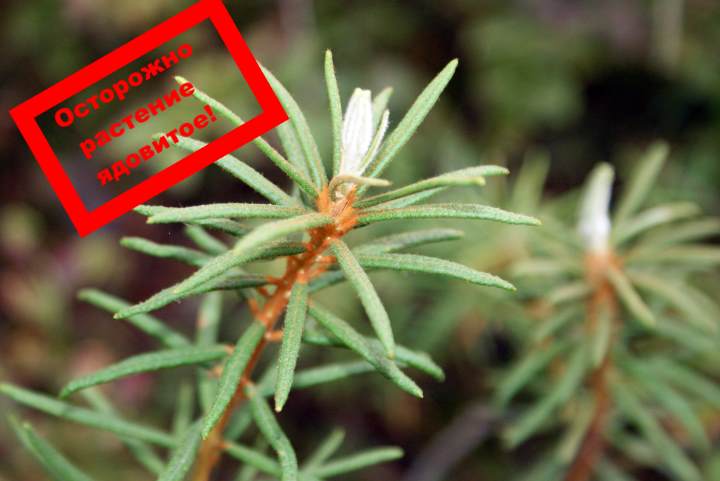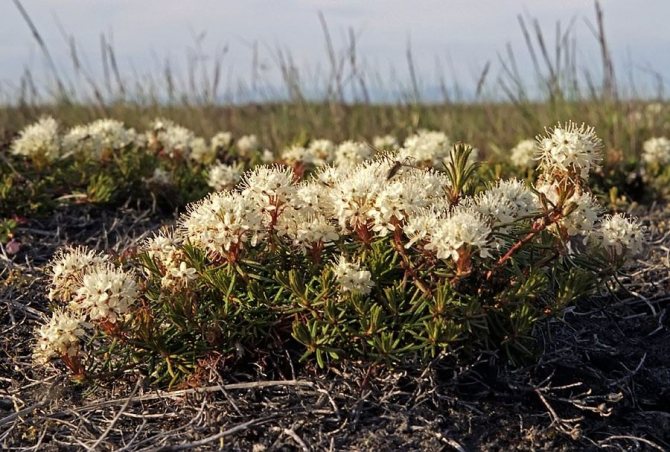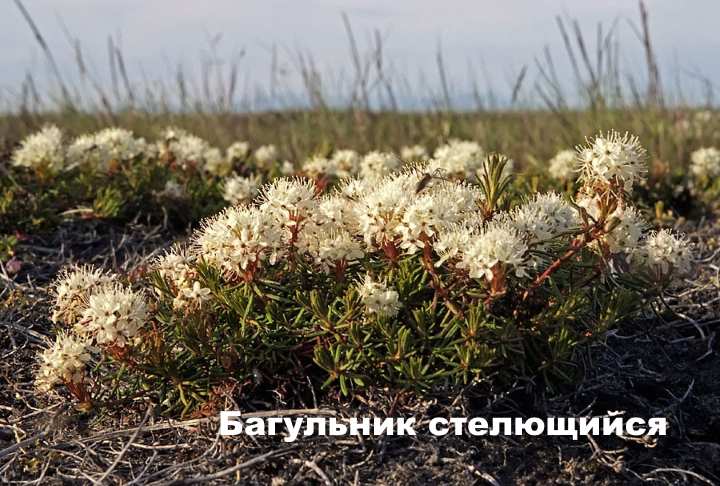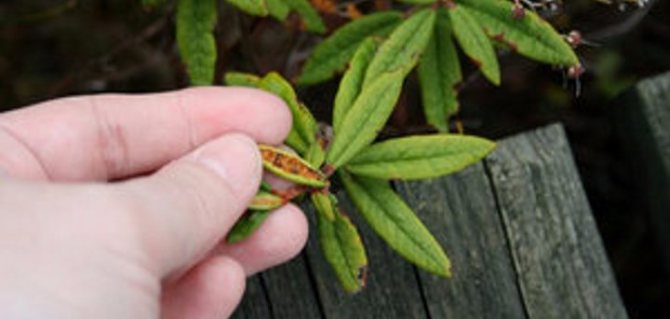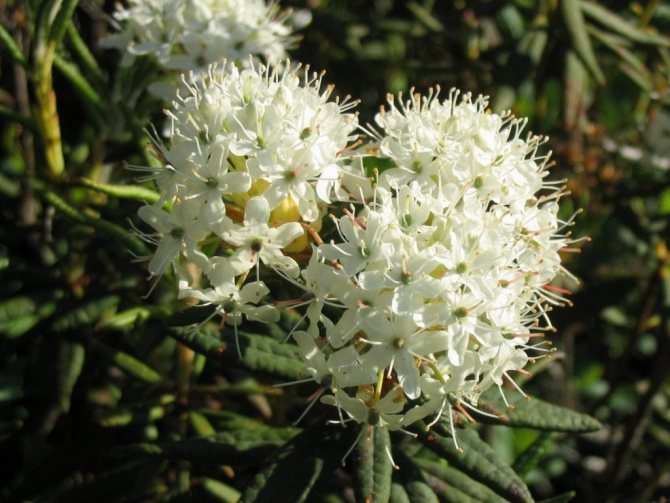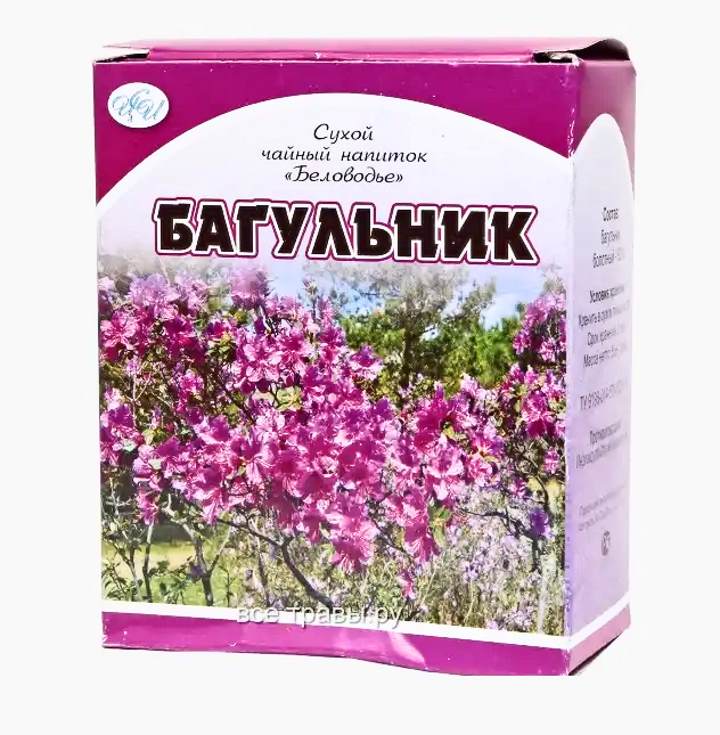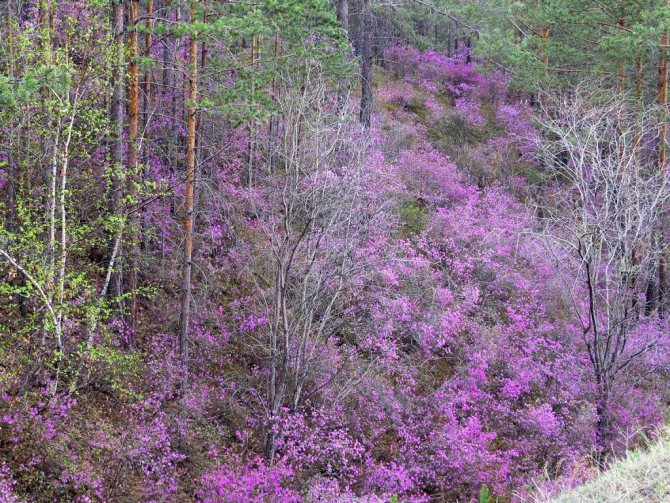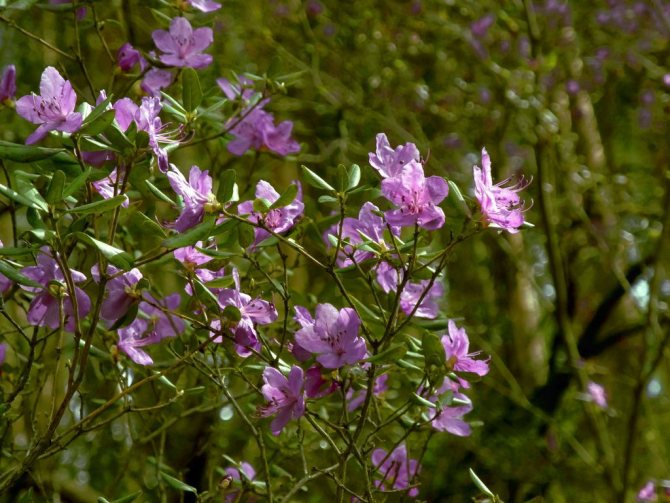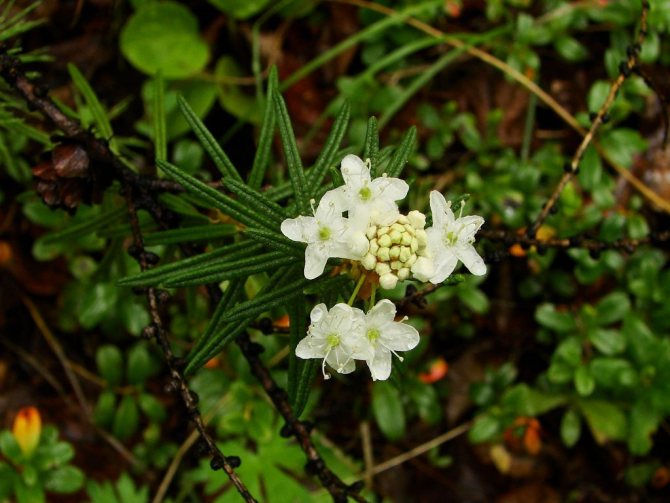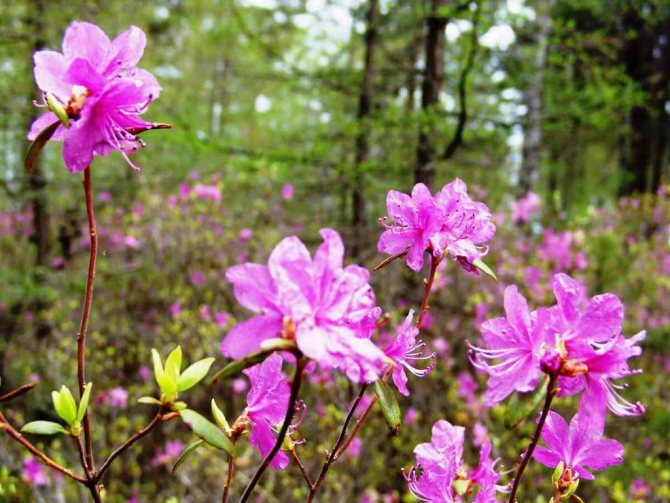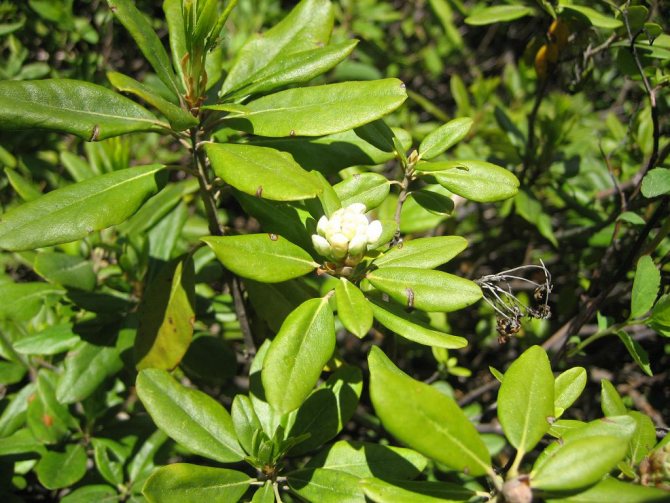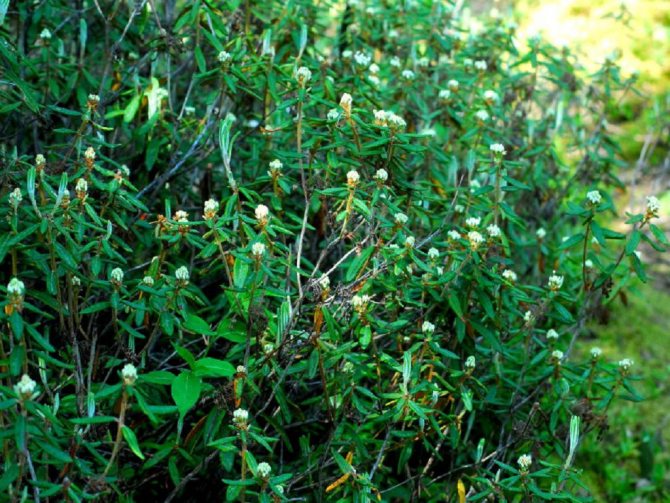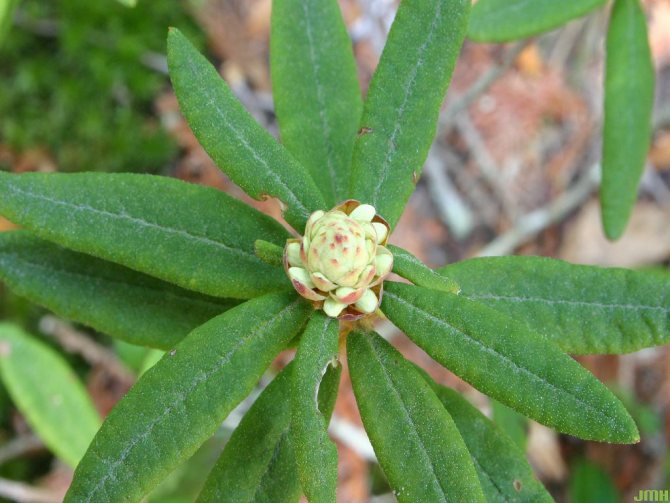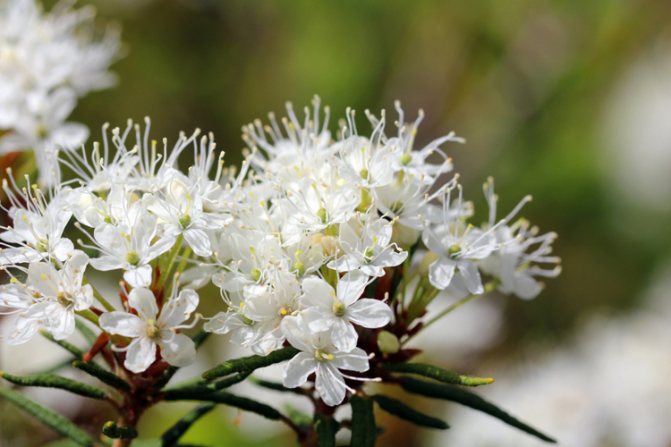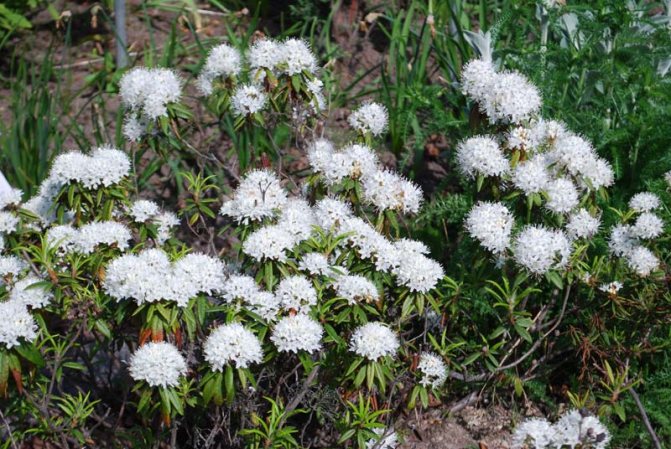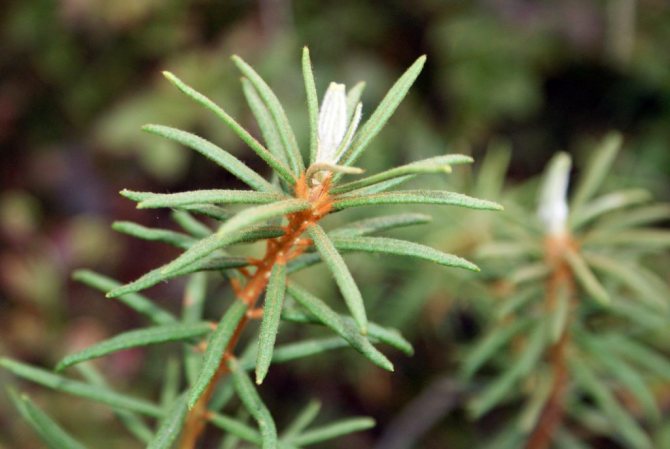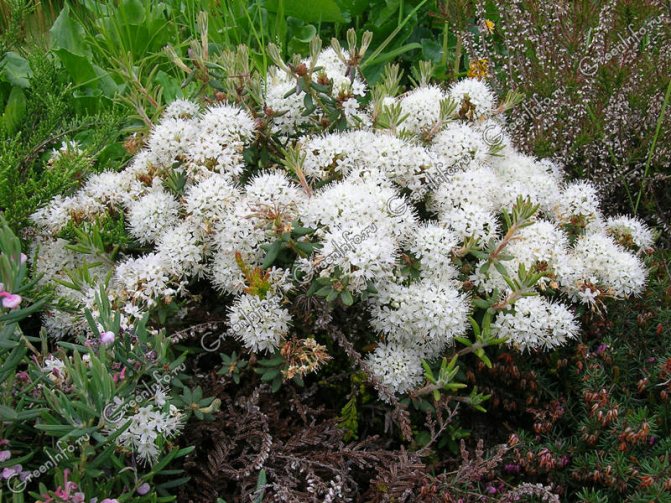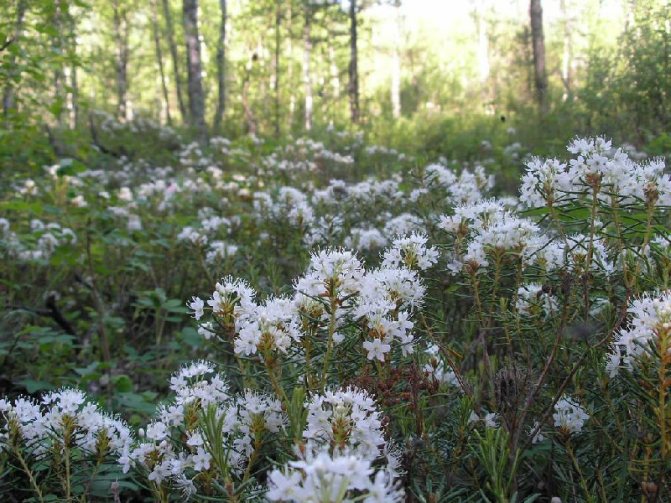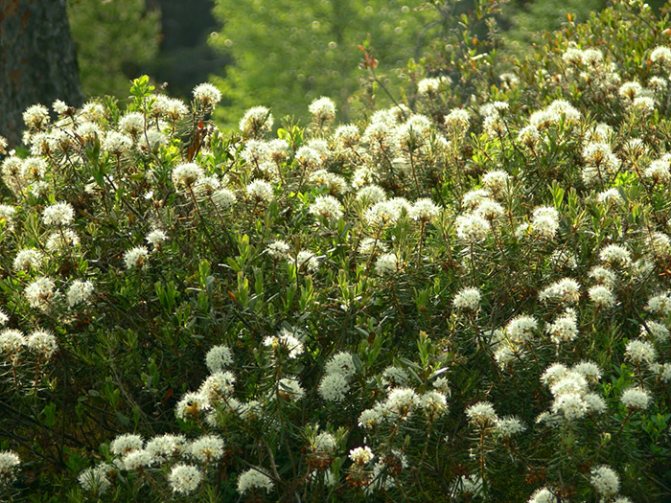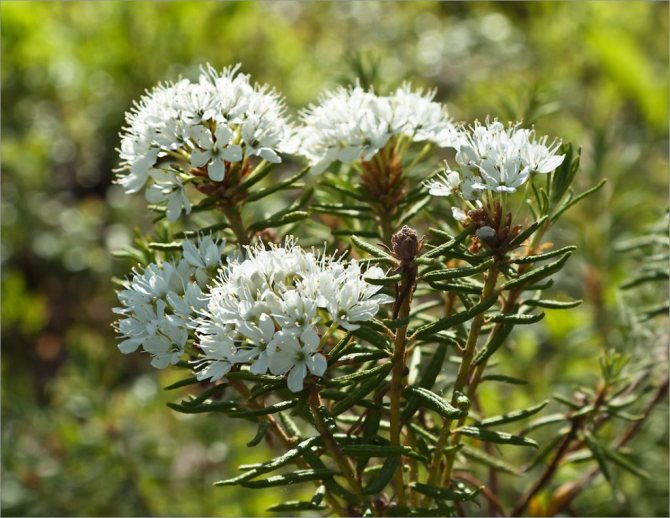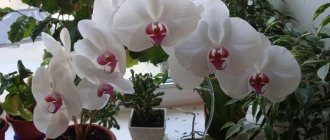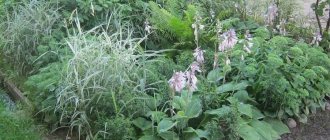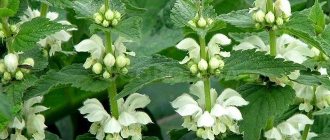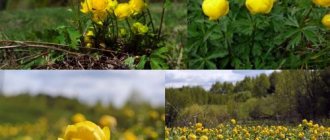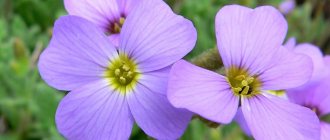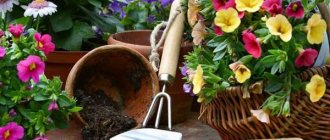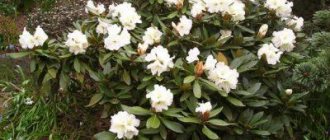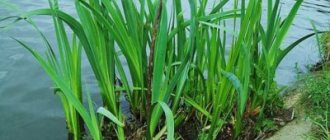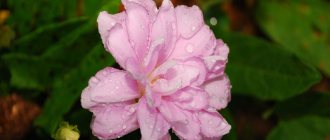
Marsh ledum (Ledum palustre L.), along with large-leaved, creeping and other species, belongs to the genus Ledum. But regarding its belonging to a specific family, Russian and Western botanists still have disagreements to this day. In Russian publications, this plant is classified as a member of the Ericaceae family, and in foreign publications - to the Rhododendron family.
The people call it a bagun, marsh, bedbug. There are eight species of wild rosemary, common in the temperate and arctic climates of the Northern Hemisphere. The most common in our country is marsh ledum.
Check out the photo and description of the marsh rosemary, as well as learn about its use for decorative and medical purposes.
What does wild rosemary look like
Ledum belongs to the Heather family, according to domestic scientists, but foreign scientists attribute it to Rhododendrons. Therefore, we can often meet confusion, for example, the Daurian rhododendron is called Ledum. This shrub is an oligotrophic plant, which means it will grow well on poor and acidic soils with poor lighting.
Ledum is a very poisonous plant. Its flowers are good honey plants, but even honey from them will be poisonous, without harm to the body, only the bees themselves can eat it. Not only the flowers are poisonous, but the plant itself is completely.
It blooms in late May. It blooms very beautifully with white or pink flowers. The photo confirms the beauty of those places. There are so many flowers that when you look at the bush, it seems that there are no green leaves at all. Along with the aroma, essential substances enter the atmosphere during flowering. Their concentration in the air is very high, and therefore destructive for both humans and animals.
A person who has been surrounded by a flowering bush for at least a few minutes will experience dizziness, headache, nausea, and may even faint from inhaled etheric substances. Animals bypass the place of flowering of this plant, but if they did get hit, then like people, animals begin to feel bad, lose activity, a feeling of exhaustion and weakness appears. Such cases are common with hunting dogs.
Using wild rosemary in the garden
Ledum trees of all kinds are very graceful and interesting plants. Planted in the garden, they will always decorate it. The smell of fresh leaves and branches of wild rosemary scares off blood-sucking insects, protects fur and wool from moths. In addition, they will protect you, because the substances secreted by their leaves kill bacteria harmful to humans. And who knows, perhaps in the near future, medicine will thank nature for creating this "insidious" bush and forgive its intoxicating properties.
Attention! During flowering, it releases substances into the air that, in large quantities, have an adverse effect on humans (headache). Not only the plant itself is poisonous, but also the honey collected from its flowers (the so-called "drunken" honey, which cannot be eaten without boiling). Therefore, although some authors classify this plant as an ornamental plant, one should think about whether to grow it in a heather garden or not.
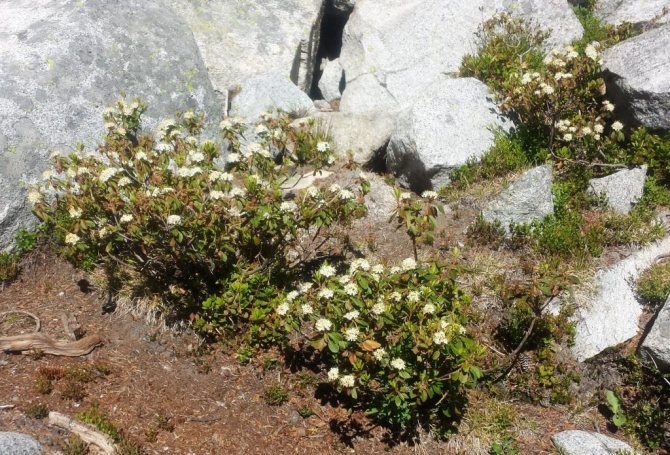

Greenland wild rosemary.
Types of wild rosemary
There are four main types of wild rosemary:
- Swamp. This plant is very common both in nature and culture.In another way, it is often called bagun or forest rosemary. It is a highly branched and evergreen shrub. The height can be from 50 to 120 centimeters, and the diameter of the bush is about a meter. The leaves are greasy, dark, shiny with a pointed tip. The edges of the leaf curl strongly downward. The flowers are white or light pink, collected in multi-flowered umbrellas. They smell pungently. Some use this plant as an ornamental one, but remember that it is poisonous and think about where to plant it and what is the permeability of people in this place;
- Creeping. It is so called because of the size of 20-30 centimeters in height. This evergreen shrub grows in the tundra, woodlands, hummocks, sandy hills, swamps and cedar forests. It blooms from late May to mid-June with small white flowers of corymbose inflorescence at the tops of the shoot. There are always few flowers. It grows very slowly, by an average of 1 centimeter per year.
- Greenlandic. This evergreen shrub, about one meter in size, grows in peat bogs. It is rarely found in culture, only in collectible botanical gardens. Oblong leaves can be up to 2.5 centimeters long. White flowers are collected in umbellate inflorescences. It begins to bloom in mid-June and continues to bloom until the end of July. This shrub has high frost resistance. Even if some shoots freeze, this will in no way affect the decorative effect of the plant. Some forms of this variety are recommended for planting in heather gardens;
- Large-leaved. The height of this evergreen shrub reaches one and a half meters. It grows in sphagnum bogs, in the undergrowth in the area of mountain coniferous forests and among thickets of heather shrubs. Blooms from late May to late June. The bloom is very abundant. The frost resistance of the plant is very high.
Precautions
Despite its widespread use, one should never forget how poisonous and dangerous it can be. And just when it has the most healing properties, you need to handle it with extreme caution - during the flowering period.
Intense aromas can provoke nausea, paralysis of the limbs, severe dizziness, and vomiting in a person. If you do not know exactly the required dosages, never use rosemary as decoctions and tinctures.
An overdose threatens you not only with a terrible intoxication of the body, but also with paralysis of the respiratory and cardiac muscles.
In no case should wild rosemary be taken with hypotension (low blood pressure), vegetative disorders, kidney disease and hepatitis.
On the network, there are photos of pregnant women against the background of a blossoming wild rosemary. This is strictly prohibited - pregnant and lactating women should not even come close to this bush!
As you can see, there are a lot of contraindications and this is not the whole list. Therefore, you need to think hard before engaging in treatment, and even more so, self-medication, with the help of this beautiful and dangerous shrub. In the pharmacy, you can easily find various drugs that are made on the basis of wild rosemary, and all dosages have already been observed there.
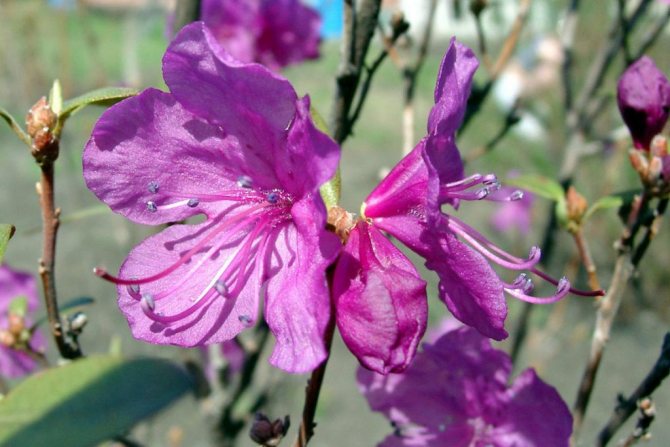

Description
Evergreen shrub with upright branches, strongly branched. The root system is superficial. Young branches are brown-pubescent with red glandular hairs. Leaves are alternate, leathery, shiny, dark green, linear-oblong, with edges bent downwards, underneath covered with rusty-brown felt and small yellow glands, do not fall off for the winter. The flowers are small, white or pink, fragrant, on long pedicels, collected in apical multi-flowered umbellate shields. A calyx of five sepals, a star-shaped corolla, of five non-accrete petals. There are ten stamens, a pistil with a five-celled ovary and a five-lobed stigma. The corolla falls off after flowering. The fruit is an oblong-oval drooping opening capsule. Seeds are very small, light yellow. Propagated by root suckers, less often by seeds.The plant has a strong intoxicating scent. A long stay in wild rosemary thickets causes dizziness, headache, intoxication, and sometimes even vomiting. Plant height 50–120 cm. There are eight species of wild rosemary.
The plant is poisonous.
> Distribution
It is found in the forest and tundra zones of Europe, in Siberia and the Far East.
> Habitat
It grows in peat bogs and marshy meadows and in moist coniferous forests. Often forms large thickets.
> Flowering time
May – July.
> Collection time
July – September.
And the name suited him
In Siberia, wild rosemary is the name for deciduous rhododendrons that bloom profusely in early spring. This is wrong, but it is so common that I, without further ado, will call them that. Moreover, true wild rosemary (Ledum) and rhododendrons (Rhododendron) are so close that not all botanists are recognized as separate genera. Indeed, wild rosemary and rhododendrons have much in common. What, apart from the size of the flowers, they differ personally, I do not know. They are all shrubs. Leaves that have not fallen for the winter on both sides curl up into tubes with the onset of frost. The flowers of this wild rosemary, although small, have a structure typical of all rhododendrons: a corolla of five petals and, characteristic of both of these shrubs, long, far protruding stamens. And even if we touch upon their agricultural technology, then here they have similar preferences. As for the Siberian rhododendrons called wild rosemary (and there are 4-5 species), their differences are even more blurred. If you do not look too closely at the details, then from a distance they are practically the same person. And their flowers, with the possible exception of Schlippenbach's rhododendron, are difficult to distinguish at close range. Dahurian rhododendron (R. dahuricum) - due to the prevalence, it is this species that most often comes under the name rosemary. Its discontinuous range extends from Altai to Sikhote-Alin. Deciduous shrub with a typical height of 70-120cm (rarely up to 2m). Leaves are elliptical up to 6 cm long, with a width of up to 2 cm, on short petioles. In autumn, most of the leaves turn yellow and fall off, but a few pieces at the top remain on the bush for the winter. Flowers with a diameter of about 4 cm in various shades of pink, occasionally almost white, fragrant. It begins to bloom a week before the leaves bloom on the birch, so the flowering of the shrub is very noticeable. In nature, flowering lasts up to a month, in culture it blooms for about 15 days. Photophilous. It is completely winter-hardy, but winters with thaws cause it to awaken prematurely, and the subsequent death of flower buds. Grows well on ordinary garden soils with the addition of high-moor peat. Rhododendron Ledebour (R. ledebourii) - semi-evergreen shrub with a typical height of 60-90cm (up to a maximum of 2m). Leaves are elliptical, rounded or obtuse, 1-4 cm long, up to 2 cm wide, leathery olive green. The apical leaves usually remain for the winter and are gradually replaced by new ones in the spring. Grows in Altai and Sayan Mountains. The flowers are pinkish-purple or lilac-pink, 3-4.5 cm in diameter. Blooms in early May, when the forest turns green. It blooms for 15-18 days. Rhododendron pointed (R. mucronulatum) - deciduous or semi-evergreen shrub 80-150cm high (up to 3m in nature). It grows in the south of the Primorsky Territory, in Korea, in the north-east of China. Leaves are oblong-elliptical, 5-7 cm long, up to 2 cm wide. The flowers are purple-pink, wide open, 4-5cm in diameter. Blooms in early May for more than two weeks. Rhododendron sihotinsky (R. sichotense) - semi-evergreen, 60-100cm. The leaves are olive green, round-elliptical, 2-4 cm long, with a width of up to 2 cm. When cold weather sets in, they roll up into tubes. Flowers broadly bell-shaped, light purple or violet-pink, up to 4.5 cm in diameter. Blooms in mid-May and blooms around the crescent.Grows in the Primorsky Territory in the Sikhote-Alin mountains. Schlippenbach's rhododendron (R. schlippenbachii) - deciduous shrub with a height of 100-200cm (in nature it reaches 5m). Leaves are obovate, 5-9 cm long and 3-6 cm wide, green, turn yellow or red before leaf fall. The flowers are wide open, up to 8-10 cm in diameter, light lilac or pale pink with dark red dots. Blooms in early May, blooms for about three weeks. Distributed in the Russian Far East - in Primorye, Korea, China, Japan.
Infusion
Infusion inside - as an antitussive and bactericidal in acute and chronic bronchitis, pneumonia, tuberculosis, whooping cough and other diseases accompanied by cough. With spastic enterocolitis, endometritis, jaundice, liver diseases, cholecystitis, shortness of breath, asthma, oliguria, diathesis, eczema, gummazy ulcers, tuberculous lymphadenitis, urethritis and as an abortive agent, with angina pectoris and various forms of rheumatism. For insomnia and as a means to dilate blood vessels, improve circulation and moderately lower blood pressure. The infusion is added to wine for alcoholism.
Infusion externally - for hair growth, for gout, arthritis, skin diseases, wounds, frostbite, in the treatment of tumors; in the form of baths, lotions and poultices - for various gynecological diseases, diathesis, hematomas, bruises, wounds, snake bites, poisonous insects, dermatomycosis, chickenpox, blepharitis, conjunctivitis.
For infusion, the daily dose is 1 tablespoon of dry, chopped herbs. In case of an overdose, headache, dizziness, agitation and irritability are possible, followed by depression of the nervous system.
- Pour a teaspoon of wild rosemary herb with two glasses of boiling water, leave for 30 minutes and take 1 tablespoon 4 times a day to gently lower blood pressure.
- Two tablespoons of dry chopped wild rosemary herb pour 500 ml of boiling water. Insist in a thermos for 30 minutes, strain and take 1/3 cup 3 times a day 30 minutes before meals.
- Insist a teaspoon of wild rosemary herb for 8 hours in 2 glasses of cooled boiled water in a closed vessel, drain. Take 1/2 cup 4 times a day.
- Two tablespoons of dry crushed rosemary herb are placed in an enamel bowl, pour 200 ml (1 glass) of hot boiled water, cover with a lid and heat in a water bath for 15 minutes, cool for 45 minutes at room temperature, squeeze the remaining raw materials. The volume of the resulting infusion is brought to 200 ml with boiled water. It is taken warm, 1/4 cup 2-3 times a day after meals as an expectorant and bactericidal agent for chronic bronchitis and other lung diseases, accompanied by cough. The prepared infusion is stored in a cool place for no more than 2 days.
- Brew two tablespoons of wild rosemary with a glass of boiling water. Insist. Take 1/4 cup 2-3 times a day after meals for the treatment of bronchitis and bronchial asthma. For whooping cough, give children 1 teaspoon 3 times a day.
- Brew 15 g of dry wild rosemary with a glass of boiling water, leave for 30 minutes, drain. Wet sterile napkins in warm infusion and put on eyes. The same infusion can be used to treat skin diseases, inhalation and gargle.
Photo gallery of views
Oil, ointment
Outwardly, an ointment on animal fats, a decoction in vegetable oil is used for skin diseases: eczema, scabies, insect bites, bruises and frostbite; drops - for rhinitis, flu. Flowers steamed in vegetable oil - as a strong pain reliever for bruises, bruises, gout, arthritis, and skin diseases.
Decoction in vegetable oil: mix 2 tablespoons of chopped wild rosemary herb with 5 tablespoons of linseed, olive or sunflower oil, leave for 12 hours in a closed vessel on a hot stove, drain.
- Use as an external remedy for rheumatism and skin diseases.
- In case of a runny nose, instill 1-2 drops in each nostril.
- Rub into scalp to remove nits and lice.
Ointment on animal fats: warm the ointment base in a water bath, mix part of the base thoroughly in a porcelain mortar with a pestle with the powder of a medicinal plant, then add the rest of the base. For the preparation of the ointment, usually 10–25% of plant materials from the total volume are used. Store the ointment in a cool, dark place.
Ointments based on animal fats are perishable and cannot be stored for a long time.
Diseases and pests
Ledum has good disease resistance and is rarely damaged by pests if you create comfortable conditions for it. Fungal diseases occasionally occur with insufficient soil aeration.
Of the pests, it is susceptible to spider mites and bugs, which cause yellowing and leaf fall. To combat them, it is necessary to spray with insecticides.
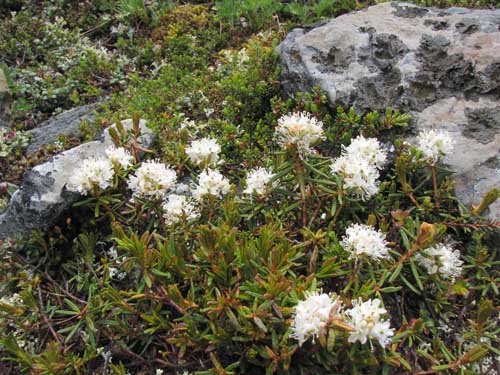

Ledum among stones
Fees
- Marsh rosemary, grass - 5 parts; St. John's wort, grass - 5 parts; pine, buds - 5 parts; field horsetail, grass - 4 parts; mint, herb - 3 parts. Pour 2 tablespoons of the collection with 500 ml of boiling water, leave overnight. Take 1/4 cup 4-5 times a day before meals for cystitis, pyelitis, urethritis. The course of treatment is up to two months.
- Marsh rosemary, grass - 70 g; stinging nettle, leaves - 30 g. 2 tablespoons of dry chopped collection pour 500 ml of boiling water, leave for 30-40 minutes, strain and drink 1 / 3-1 / 2 cup 4-5 times a day for colds, bronchial asthma, cough , rheumatism, etc.
- Marsh rosemary, grass - 20 g; stinging nettle, leaves - 15 g. Pour 1 liter of boiling water and leave for 8 hours in a closed vessel, drain. Take 1/2 cup 4 times a day after meals. For children with whooping cough, give 1 teaspoon 3 times a day.
- Marsh rosemary, grass - 30; marshmallow, roots - 70. 2 tablespoons of dry chopped collection pour 500 ml of cold boiled water, stand for 30-40 minutes, then warm in a boiling water bath for 15 minutes, strain and drink 1/4 cup 6 times a day for gastrointestinal intestinal disorders, dysentery.
- Marsh rosemary, grass - 10 g; marshmallow medicinal, roots - 25 g. Pour the mixture into 1 liter of boiling water, leave for 1 hour. Then strain and drink 1/3 cup 3 times a day after meals for a week with indigestion and dysentery.
- Marsh rosemary, grass - 20; marshmallow medicinal, roots - 40; coltsfoot, leaves - 40. 2 tablespoons of dry chopped collection pour 500 ml of cold boiled water, stand for 30-40 minutes, then warm in a boiling water bath for 15 minutes, strain and drink 1/2 cup for colds, diseases lungs and bronchi.
- Marsh rosemary, grass - 10 g; coltsfoot, leaves - 10 g; violet - 10 g; plantain - 10 g; chamomile - 10 g; anise ordinary - 10 g. Mix and grind everything. Pour 2 liters of boiling water, leave for 8 hours in a warm place, drain. Take 1/3 cup 3 times a day for tracheobronchitis and bronchospasm.
- Marsh rosemary, grass - 20; coltsfoot, leaves - 20. A tablespoon of the mixture is poured with 200 ml of hot water, boiled for 5 minutes, then filtered. Take a tablespoon every 2 hours.
Herbalist B
Ledum is an evergreen shrub from the Heather family. The scientific name - ledum - brings it closer to incense, as the dense leaves also exude an intense woody scent. The word "wild rosemary" is translated from the Old Russian language as intoxicating, poisonous, intoxicating. Sometimes the plant is called oregano, hemlock, wild rosemary, goddess. Its habitat is quite wide. It affects the Northern Hemisphere, in particular the temperate subarctic belt. Ledum is very often used for medicinal purposes, but it can also be used to decorate the garden.
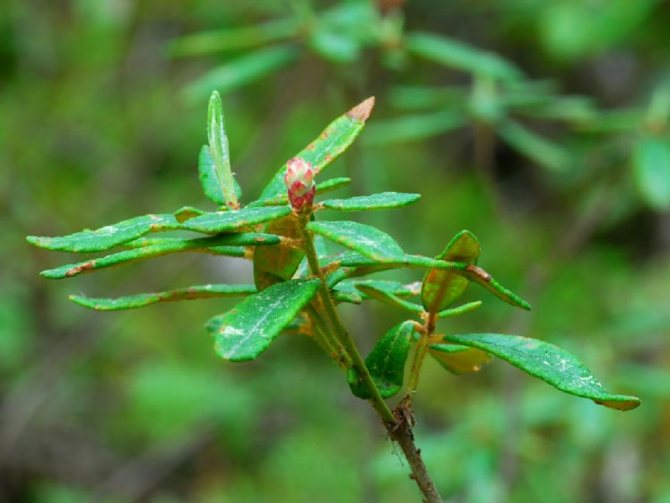

Contraindications to the use of wild rosemary
10 reasons to eat apples every day How to delay old age or Prolong youth Anthurium flower is a capricious tropical beauty All parts of the rosemary plant are poisonous, so you need to be careful when using it, do not overdose !!! The use of drugs during pregnancy, with low blood pressure is contraindicated.


Video about the use, collection and medicinal properties of wild rosemary
Plant appearance
Ledum is a perennial shrub or shrub 50-120 cm high. It is fed by a branched surface rhizome with short shoots. Rigid branched stems do not differ in large diameter. They can be erect, ascending, or creeping. Olive green young shoots are covered with rusty pubescence, but over time they are covered with bare dark bark.
Leathery short-petiolized foliage persists throughout the year. It has an elongated or lanceolate shape with a raised central vein and edges curled downwards. The color of the leaves is dark green. It turns brownish brown in bright light. Leathery leaves grow next. When rubbed, they give off a sharp intoxicating smell.
In April-June, dense umbellate inflorescences bloom on the shoots of last year. Each flower has a short pedicel. White oval petals form a bell-shaped cup. The number of all elements of the flower is a multiple of 5. The wild rosemary is pollinated by insects, after which dry seed pods with 5 sections ripen. Small winged seeds huddle in them.
The genus of wild rosemary has only 6 plant species. 4 of them grow on the territory of Russia.
Marsh Ledum. A typical representative of the genus, common in temperate climates. It is a dense bush up to 1.2 m high. Raised branchy shoots are covered with rusty short hair. The dark green, glossy leaves exude a pleasant scent. At the end of spring, dense umbrellas or shields with white or light pink small flowers bloom.
Marsh wild rosemary
Greenland wild rosemary. Rigid lodging stems grow up to 90 cm in length. They are light brown in color. On the shoots, narrow linear leaves are located close to each other, like bright green soft needles. Felt pile is present on the reverse side of the twisted leaves. During the flowering period, small (up to 6 cm wide) umbrellas with white or cream flowers bloom. The view perfectly tolerates even severe frosts.
Greenland wild rosemary
Large-leaved wild rosemary. The inhabitant of the Far East, Japan and Korea grows 40-80 cm in height. It settles on rocky embankments and mountain slopes. Oval foliage is 3-4 cm long and 8-15 mm wide. On young shoots and the reverse side of the leaves, there is a thick red pile.
Large-leaved wild rosemary
A few years ago, rhododendron was a synonym for wild rosemary. Until now, some flower growers attribute the Trans-Baikal wild rosemary to this genus, but in fact it is only a distant relative and has the scientific name "Daurian rhododendron". The plant is also a highly branched bush 50-200 cm in height. The branches are covered with narrow dense leaves of a dark green color. But the flowers have a rich pink hue. Often this very "rosemary" can be seen in a vase in a bouquet arrangement.
Ledum transbaikalian
Using
Regardless of the variety, wild rosemary is an elegant and very interesting plant. The beautifully blooming wild rosemary decorates the garden. The smell of its leaves and stems repels insects.In addition, the plant protects a person from bacteria harmful to him, they die next to the wild rosemary. But when growing this shrub in your garden, you should always remember that when wild rosemary blooms, many toxic substances are released into the air that cause poisoning of the human body. During this period, you should protect yourself from their effects: do not be near the rosemary and even more so do not smell its flowers.
Reproduction methods
Ledum breeds excellently by seed and vegetative methods. In nature, new plants are more likely to emerge from seeds. They are collected from matured small bolls, which independently crack from bottom to top. From a distance, achenes resemble tiny chandeliers. Seeds are harvested in autumn, but sown only in early spring. For this, containers are prepared with loose garden soil mixed with sand. The soil should be loose and moist, and also have an acidic reaction. The seeds are spread on the surface and only slightly pressed into the soil. The container is covered with transparent material and placed in a cool place. The greenhouse is periodically ventilated and watered. Seedlings appear in 25-30 days. The grown seedlings are seated in separate peat pots or in another box with a greater distance so that the roots do not get tangled.
It is convenient to propagate garden plants by layering. To do this, flexible branches are tilted to the soil and fixed in a hole with a depth of 20 cm. The top must be left on the surface. After rooting, the shoot is separated.
A large bush during the spring transplant can be divided into several parts. To do this, the plant is completely dug up, freed from the ground and cut into divisions. Places of cuts are processed with crushed charcoal. The roots do not dry out and immediately determine the seedlings to a permanent place.
For grafting, semi-lignified shoots with 2-3 leaves are cut during the summer. The lower cut is treated with growth stimulants and shoots are rooted in pots with loose and nutritious soil. The leaves closest to the soil are cut off completely or the leaf plate is shortened. Rooting and adaptation takes a long period, therefore, seedlings are transferred to open ground only next spring.
Reproduction
Seeds and summer cuttings are planting material for wild rosemary. In order for the cuttings to quickly root and take root, their sections must be treated with heteroauxin, that is, placed in a solution (0.01%) for a period of 16-24 hours. Then rinse under running water and only then plant in a container with soil. It is important to know that callus, even on a treated cuttings, is formed by autumn, and the roots themselves will grow only by the next season.
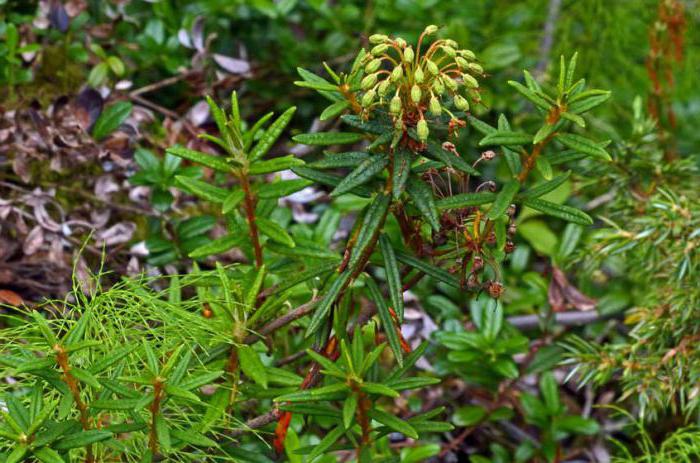

Planting and leaving
Ledum belongs to unpretentious plants, so it does not cause much trouble to the owners. Planting is best done in spring, although this is not necessary for plants with closed rhizomes. Since the roots are located close to the surface of the earth, the planting hole is dug 40-60 cm deep. River sand or pebbles 5-8 cm thick are poured at the bottom. The soil itself should be sufficiently acidic and loose. It is advisable to plant bushes on wet soils with the addition of needles. If several plants are planted at once, the distance between them is 60-70 cm. After all work is completed, the soil is tamped and watered abundantly. Then the ground near the bushes is mulched with peat.
In its natural environment, wild rosemary grows near water bodies, so regular watering is of great importance. Irrigation is not needed only with frequent precipitation. Lighting for plants is not very important. They feel equally good in a sunny place and in partial shade. Even with strong shading, wild rosemary will not die, but it may look less decorative and bloom less often.
From time to time, the soil should be loosened and weeds removed. However, do not forget that the roots are located close to the surface, so be careful.Several times a season (in spring and summer) wild rosemary is fertilized with mineral complexes. Pruning is carried out in March and October. The sprouts that break out of the given shape are shortened, and dry and damaged branches are also removed.
Winters are not terrible for wild rosemary. It perfectly tolerates even severe frosts, however, in the absence of snow, the young growth can freeze to the height of the snow cover. In the spring, it is enough to remove the affected branches and young growth will quickly take their place.
Ledum is resistant to plant diseases. He is not afraid of soil flooding, but only with regular loosening. Without air access, the fungus can still develop. Very rarely, bugs and spider mites settle on the shoots. They are easy to get rid of with insecticides. More often, the plant itself scares off annoying insects, including from neighbors in the flower bed.
Ledum care
Although wild rosemary grow on poor soil in the garden, they need nutrition to grow well. Therefore, it is important to feed the plants. It is better to do this in the spring, once a season. For top dressing, a complete mineral fertilizer is used at the rate of 50-70 grams per m2 for each adult plant, for young plantings - 30-40 grams per m2.
In dry and hot summers, wild rosemary need watering. Therefore, at least once a week, they should be watered abundantly with 5-8 liters of water per plant. After that, the soil around the bushes can be carefully loosened and be sure to mulch with peat to retain moisture. They loosen the ground, as already noted, very carefully, since the roots are located close to the soil surface.
Ledulniks do not need special pruning. To maintain a decorative appearance, only dry and broken twigs after winter are cut off.
In cultivation, wild rosemary are resistant to diseases and pests, probably due to the repelling strong smell.


Seedling of marsh wild rosemary.
Beneficial features
Leaves and flowers of wild rosemary contain many biologically active substances recognized not only by folk, but also by official medicine. Among them:
- essential oils;
- tannins;
- flavonoids;
- ascorbic acid;
- gum;
- phytoncides.
Since ancient times, the broth has been used as an antiseptic and antibacterial agent. It was used externally, added to baths or compresses, and also drank to fight coughs, SARS and intestinal infections.
Tea with rosemary leaves soothes and fights insomnia. The plant copes well with diseases such as pneumonia, whooping cough, bronchitis, liver and kidney disease, gastritis, eczema, boils, chickenpox, cholecystitis. Drugs are also useful for women's health. They strengthen muscles and fight sexually transmitted diseases. Moreover, in different countries, the "specialization" of wild rosemary may differ.
They have plants and household purposes. The smell of foliage scares off blood-sucking insects and moths.
Ledum is contraindicated for people suffering from allergies and sensitive to plant components. Since it increases the tone of the uterus, the treatment is unacceptable for pregnant women. And of course, the dosage should not be exceeded, so it is better to carry out treatment under the supervision of a doctor.
Why is wild rosemary so useful
The main value of wild rosemary lies precisely in essential oils, which are so rich in its aerial part. When wild rosemary is in bloom, it has the highest possible oil content. That is why the best harvest time is the flowering period. In addition, the amount of oil and its concentration depends on the growing area.
Ice-oil is a poisonous substance, which is rich in essential oils of wild rosemary. It is this that gives the essential oil a greenish tint, thickness and burning taste. But besides this, ice-breaker has antitussive and enveloping properties, therefore, it is fundamentally wrong to talk only about its uselessness. On its basis, many medical preparations have been created - bactericidal, sedative, stabilizing high blood pressure.Blooming wild rosemary is also a storehouse of other useful vitamins and minerals, ascorbic acid, phytoncides and flavonoids.
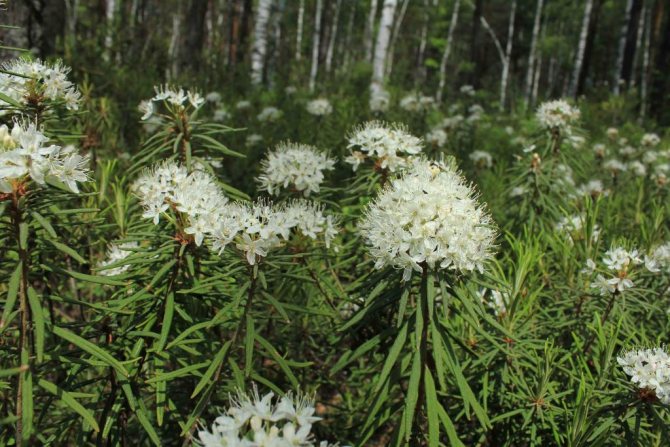

Signs and superstitions
The wild rosemary herb is shrouded in a large number of legends, it will also take superstitions, so many doubt whether it is worth keeping it in the house. Although some are wary of wild rosemary, it is very useful, prevents the spread of pathogenic microbes in the air and heals the body. Of course, if you leave a lot of flowering branches in a small room, the household will be haunted by a headache. Hence the omen that wild rosemary increases nervousness, irritability and brings troubles. But a couple of sprouts won't hurt at all. On the contrary, they will cleanse the atmosphere of negative energy and fill the room with a pleasant, unobtrusive aroma.
The Russian name "wild rosemary" comes from the old verb "wild rosemary", which means "to poison", and the adjective "wild rosemary", forgotten in our time, derived from it, means: poisonous, stupefying, tart, strong. This name reflects the characteristic feature of this shrub - a strong, suffocating smell. The scientific name for wild rosemary - "Ledum" (Ledum) comes from the Greek ledon - as the ancient Greeks called the plant from which the aromatic resin was extracted - frankincense (ladanum).
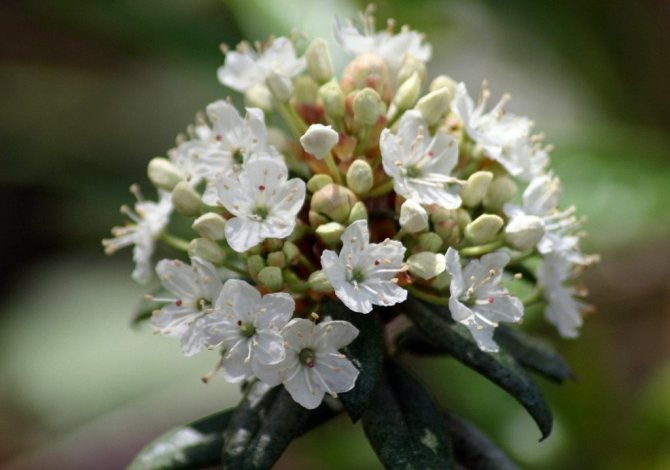

Greenlandic rhododendron, or Greenlandic ledum.
Marsh wild rosemary: how to collect and where it grows?
Of course, the question immediately arises of how best to properly collect the wild rosemary plant, in order to use it in the future. So, young and leafy shoots of marsh wild rosemary are harvested from early May to mid-July, while flowers are not removed from them. With the help of a secateurs or a knife, you should carefully cut off no more than ten centimeters from the total shoot, which will become our future workpiece. Shoots should also be carefully sorted out, tied in small bunches and dried. Experienced gardeners say that drying can be done by hanging bundles on a rope in a warm, dry, moisture-free room. In this case, the room must be ventilated, otherwise rotting processes will begin in the bundles due to high humidity, and the workpieces will simply be spoiled. You can also simply send the twigs to a specialized automatic dryer, where the temperature should not be higher or lower than forty degrees, but this method is suitable only for those who have such a specialized dryer in stock. Others will have to spend some time in order to implement their plans and get quality blanks.


What does marsh rosemary look like: a photo of a plant
When the raw material is harvested, it can be shredded or left directly in bundles. Then the rosemary can be stored separately from food, as well as from medicinal raw materials. In this case, it is also best to tightly close the container in which the wild rosemary is stored so that it does not lose its taste and aroma properties. In general, when a gardener deals with wild rosemary and its preparations, it is recommended to use gloves, and also not to inhale the rosemary aromas too deeply, since in this form it may not always be useful, and may even lead to the development of an allergic reaction.
The grass Ledum Marsh, as a rule, is used either in folk medicine or in medicine at the official level. In addition, wild rosemary is excellently used in homeopathy, as it has a large number of nutrients and components that are incredibly useful for human life and health. Also, the medicinal marsh rosemary can be used for the following purposes - to make up a variety of perfume compositions.Fight insects and pests that are deterred by the scent of wild rosemary and its essential oils can be completely poisonous for some pests; dressing of leather and its subsequent tanning, processing; landscape design, creation of unique flower and garden compositions, planting wild rosemary in single and group plantings, drawing up flower beds; sometimes wild rosemary can also be used to collect honey. In general, of course, do not forget that wild rosemary is a plant belonging to the class of poisonous, therefore it can be used for medicinal and other purposes, but this should be done with extreme caution and be sure to be under the supervision of a doctor. It must be remembered: any attempts at self-medication can lead to completely opposite consequences and can also be very dangerous to human life and health. So do not experiment and risk your health using a variety of herbs, even if they initially have a medicinal effect.
Of course, like any plant, the wild rosemary herb also has some contraindications. We will devote the next part of this article to them.
Description of wild rosemary
Ledum (Ledum) is a genus of plants from the Heather family.
In the Western literature, species of the genus Ledum has been included in the genus Rhododendron since the 1990s; in the Russian untranslated literature, such a view of the classification of this genus has not been previously supported.
Ledum grows in the cold and temperate zones of the Northern Hemisphere. There are 6 types, 4 of which are common in Russia. Ledum is represented by shrubs and shrubs with evergreen, alternate, whole-edged, leathery, often with a curled edge, leaves.
The leaves and branches of wild rosemary emit a sharp intoxicating smell, which is explained by the content of a complex essential oil in the plant, which has poisonous properties that affect the nervous system and causes dizziness, headache, nausea, vomiting, and sometimes loss of consciousness.
The flowers are bisexual, white, five-dimensional, in umbellate or corymbose inflorescences at the ends of last year's shoots. The rosemary fruit is a five-celled capsule that opens upwards from the base. The seeds are very small, winged.
Ledum is propagated by seeds, in culture - by cuttings, layering, dividing bushes and root suckers.
Rhododendron Daurian is often called wild rosemary, the branches of which are sold in winter. But the Daurian rhododendron has nothing to do with wild rosemary.
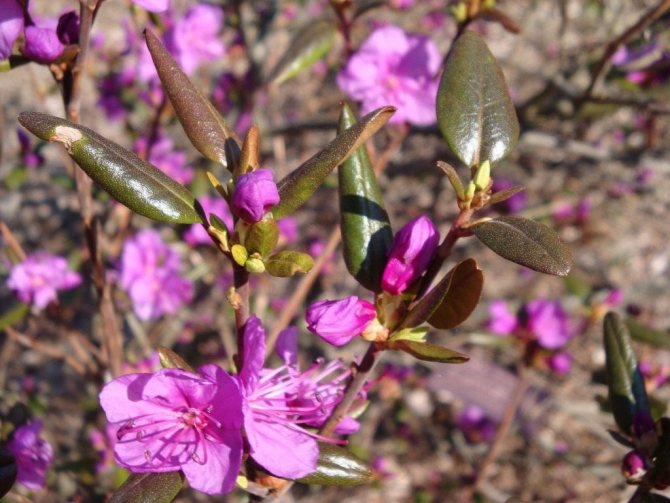

Rhododendron daurian (Rhododendron dauricum). <>
Into a notebook.
Heather land - the upper layer of forest litter with a thickness of 10-20 cm, including part of the bedrock, from an old pine or spruce forest, in the lower layer of which such species as lingonberry, heather, wild rosemary, bilberry, cranberry, blueberry, etc. grow. It is useful to add heather soil under all heather rhododendrons little by little, but constantly, thus imitating the process of fertilizing heathers in nature with coniferous litter. Heather soil has an acidic reaction, is rich in organic matter and, which is very important, is inhabited by mycorrhiza of useful fungi. Leaf land - the upper, most organic-rich part of the soil from the old forest, in the stand of which such species as linden, oak, maple, alder, aspen prevail. Coniferous litter - the uppermost layer of the forest floor of coniferous forests. Contains only organic matter, including both completely decomposed needles and recently fallen needles. Coniferous litter not only fertilizes the soil, but also loosens and acidifies it, makes it more moisture-consuming, contributes to the emergence and development of useful microfauna. Heather compost - is prepared from heather land, coniferous litter, pine, spruce or larch bark, rotten stumps, sphagnum, high peat, small coniferous twigs, leaves of forest trees, etc. These components are laid in thin layers somewhere in a shady place in the garden, in a wide pile 50-70 cm high. The top of the pile should be formed trough-like to delay precipitation. The compost is stored for several years until the branches and bark are completely decomposed, that is, until its constituent parts turn into a homogeneous loose mass. Mycorrhiza - mutually beneficial cohabitation (symbiosis) of fungal mycelium with the roots of trees, shrubs and herbs. All plants of the heather family, including rhododendrons, need the presence of symbiotic fungi in the soil. It is not difficult to add mycorrhiza sourdough with heather soil, and it is advisable to stimulate its development by systematic addition of coniferous litter.
Growing wild rosemary
Planting wild rosemary
The best time for planting wild rosemary is spring. However, if the plant is sold with a closed root system, then the planting time does not really matter. Since the plants are planted in a permanent place for many years, the planting pits should be 30-40 cm deep, although the bulk of its roots are at a depth of 20 cm.If you want to create a bright spot, and wait several years for one specimen to grow, do not enough patience, plant a few bushes, while the distance between plants in the group should be 50-70 cm.
Soil for wild rosemary
Ledum plants prefer acidic soils. Therefore, the pit is filled with a mixture of high peat, coniferous soil and sand in a proportion (3: 2: 1). Some species can also grow on poor sandy soils. For example, greenland rosemary and large-leaved wild rosemary, for which the soil mixture is composed of the same components, but with a predominance of sand. At the bottom of the planting pit with a layer of 5-7 cm, drainage is poured, consisting of river pebbles and sand. Planting mulch.


Ledum.
Watering
To maintain the optimal level of soil acidity, it is necessary to regularly (2-3 times a month) water the plantings with acidified water. The bushes are fed once a year in spring with full mineral fertilizer. It is enough to scatter 1.5-2 tbsp around the bush in April-May. l. fertilizers.
Tolerates waterlogging, but does not tolerate drought and soil compaction. Loosening is also desirable, but careful, because due to the root system located at the surface, the roots can be damaged
Popular types
The genus cannot boast of a large number of wild rosemary species included in it. There are only 8 of them, 5 of which have been actively used in decorative gardening since the beginning of the 18th century. These wild rosemary shrubs are popular for their unpretentiousness and beautiful flowering.
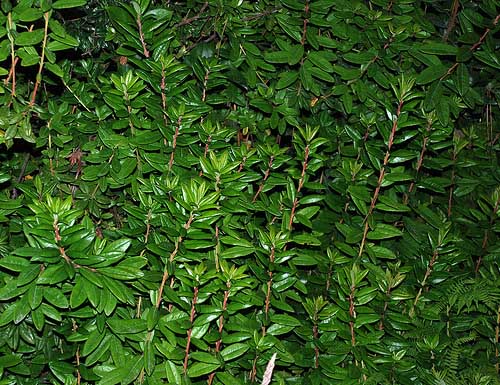

Ledum ferruginous (L. glandulosum)
Marsh wild rosemary (lat. L. palustre) - ubiquitous in gardens and parks of temperate latitudes. Its bushes do not exceed 120 cm in height on average, it is distinguished by raised, branched stems with reddish pubescence. The foliage is dark, dense and has a pleasant aroma. The flowers are small, white and pale pink, collected in numerous umbellate inflorescences. It is dangerous during the flowering period, as volatile substances are released, intoxicatingly affecting humans.
Ledum ferruginous (lat. L. glandulosum) has larger flowers, also collected in umbrellas. The leaves are wider, rounded, slightly curled at the ends.
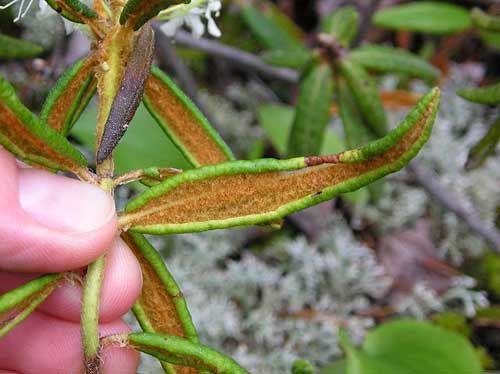

Felt leaf pubescence
Greenland wild rosemary (Latin L. groenlandicum) reaches a maximum height of 0.9 m. The folded leaves are linear, smooth on top, and soft tomentose below. Small flowers are collected in shields 5-6 cm in diameter. Differs in excellent frost resistance. The ‘Compacta’ variety looks very interesting - a low shrub up to 50 cm in height. Creamy graceful flowers are combined into globular inflorescences. The shoots are beautifully dark brown in color.
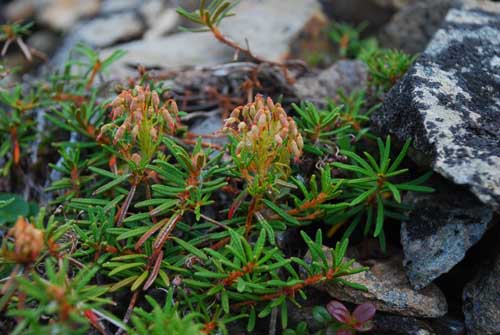

Ledum creeping (L.decumbens)
Ledum creeping (lat. L. decumbens) - the shortest species, pubescent shoots 20-30 cm long are densely surrounded by dark green oblong foliage. The inflorescences do not exceed 2 cm in diameter.
Large-leaved wild rosemary (lat. L. macrophyllum) is a tall and profusely flowering shrub, broad, light green, relatively slightly pubescent. Shoots eventually lose their reddish pubescence.
Medicinal properties of wild rosemary
Plants contain a whole range of active substances, which determines the versatility of their effects on the body as a whole. Therefore, it is very difficult to divide plants into expectorants, antitussives, bronchodilators, etc. Among the people, wild rosemary is considered almost a universal medicine. Has antispasmodic, expectorant, diaphoretic, diuretic, disinfectant, analgesic, narcotic and sedative properties, has diuretic, antimicrobial activity.
Attention! The plant is poisonous. Self-medication threatens with complications and even danger to life.
In folk medicine, wild rosemary is used for diseases of the respiratory system; bronchitis, tracheitis, laryngitis, pneumonia, influenza, bronchial asthma, cough, whooping cough, wounds, as well as snake and insect bites. Copes well with stomach diseases, dysentery, spastic enterocolitis. It is also used in the treatment of liver diseases, fever, cystitis, pyelitis, urethritis.
It is widely used in the form of baths and lotions for the treatment of external diseases (weeping eczema, frostbite, boils, scabies), eye diseases, chronic rheumatism, gout, osteochondrosis, arthritis. Has a positive effect on tuberculosis, diabetes and cancer.
Rosemary shoots are used in the form of an infusion as a means of dilating blood vessels, improving blood circulation, and insomnia. The ability of wild rosemary to moderately lower blood pressure was revealed. Patients tolerate wild rosemary well even with prolonged use, it does not cause acute toxic effects.
Ledin is industrially produced from wild rosemary shoots as an antitussive, bronchodilator. Ledum essential oil has narcotic properties that are used in the production of beer and vodka.
Why, in the first place, is it about the respiratory organs? Essential oils of wild rosemary (anise, elecampane, mint, pine buds) are very effective on the mucous membranes of the respiratory tract. The folk and clinical experience of using wild rosemary for the treatment of the respiratory system is very rich.
Marsh Ledum (Ledum palustre, or Rhododendron tomentosum)
Marsh rosemary is widespread in nature and is more common in culture. Popularly called it: bagun, wild rosemary, bagunnyak, goddess, bagunnik, bugun, marsh hemlock, puzzle, bagno, oregano, oregano, canabor, marsh canabra, big bugs, bedbug grass, marsh stupor, forest rosemary.
Homeland of Marsh Ledum Arctic, East European Plain, Western and Eastern Siberia, Western, Northern, Southern Europe, Northern Mongolia, Northeastern China, Korea, North America. It grows in the tundra and forest-tundra in peat bogs, in raised bogs, in the undergrowth of damp coniferous forests, along mountain rivers and streams, in the highlands, in groups, in small thickets, among dwarf cedar.
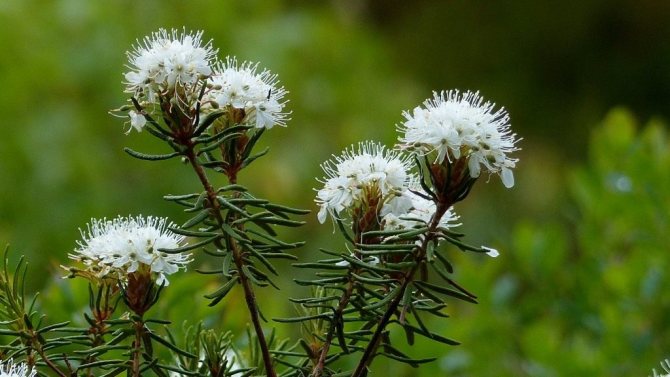

Marsh Ledum (Ledum palustre).
Marsh wild rosemary is a strongly branched evergreen shrub with a height of 50 to 120 cm, with ascending shoots covered with dense “rusty” felt drooping. The diameter of the bush in an adult state is about 1 meter. The leaves are lanceolate, dark, shiny, with a scent. The edges of the leaves are strongly curled down. Flowers (up to 1.5 cm in diameter) are white, rarely pinkish, sharp-smelling, in multi-flowered umbrellas (May-June). The capsule fruit opens with five leaves. The seeds ripen in mid-August. The roots are superficial, with mycorrhiza.
Greenlandic Ledum (Ledum groenlandicum)
The natural range of Greenlandic Ledum is the northern and western part of North America. Grows in peat bogs. It is rare in culture, mainly in the collections of the botanical gardens of St. Petersburg, Riga, Canada, the USA, Germany and Switzerland.
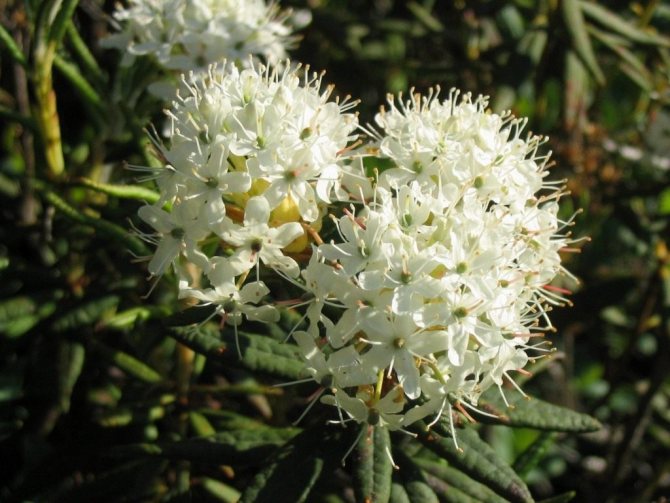

Greenlandic rhododendron (Rhododendron groenlandicum), or Greenlandic ledum (Ledum groenlandicum).
Currently, in taxonomy, the species is known under the name Rhododendron groenlandicum. Previously, the species was attributed to the genus Ledum and its name was Ledum groenlandicum; in the Russian-language literature, the species is known precisely under this name.
Greenland rosemary is a shrub up to 1 meter high, with oblong leaves (up to 2.5 cm long), white flowers (up to 1.5 cm in diameter), collected in an umbrella-shaped inflorescence. It blooms from mid-June to the second decade of July. The seeds ripen by the end of September. Moderate growth. From the end of July to autumn frosts, there are cases of secondary growth due to which, probably, the ends of young shoots do not have time to completely lignify and freeze slightly. However, this does not affect the decorative effect of the species.
Ledum decumbens
Homeland of the wild rosemary creeping: Eastern Siberia, the Far East: Chukotka, Kamchatka, Okhotia, Sakhalin, northern North America, Greenland. It grows in shrub tundra on hummocks with light forests, on sandy hills, loaches, in thickets of dwarf cedar, on high-mountain sphagnum bogs, stony placers.
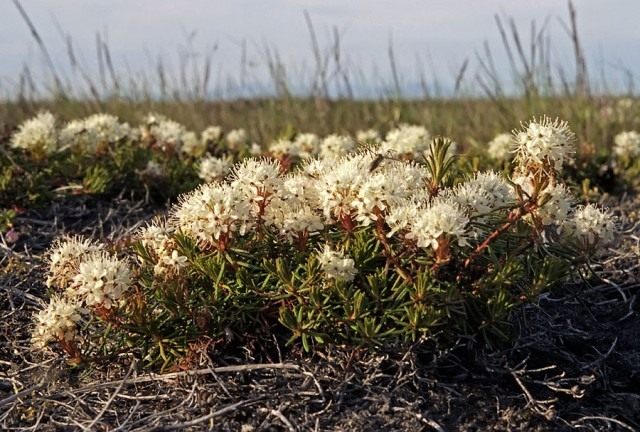

Creeping wild rosemary, or prostrate wild rosemary (Ledum decumbens). <>
Evergreen shrub 20-30 cm tall. It blooms sparsely, but annually from the second decade of May to mid-June. Fruiting irregularly. The seeds ripen at the end of August. It grows slowly, with an annual growth rate of about 1 cm.
Large-leaved wild rosemary (Ledum macrophyllum)
Homeland of Large-leaved Ledum: Eastern Siberia, Far East: Sakhalin, Primorye, Amur river basin; northern part of Korea, Japan (Hokkaido). It grows in the undergrowth of mountain coniferous forests, on sphagnum bogs, on the outskirts of stone placers among thickets of heather shrubs.
Rhododendron Tolmachev (Rhododendron tolmachevii), or Large-leaved Ledum (Ledum macrophyllum).
Large-leaved wild rosemary, described by A.I.Tolmachev in 1953, is considered a synonym for the species Rhododendron tolmachevii.
Large-leaved wild rosemary is an evergreen shrub up to 1.3 m tall. Blooms profusely, from the second half of May to the first decade of June. The seeds ripen in late August - early September. Annual growth is 3-4 cm, rarely 6-8 cm.
Healing properties
Ledum has a whole complex of active substances, so it is difficult to divide it into areas of impact on the human body. In folk medicine, wild rosemary is a universal remedy. It has an expectorant and antispasmodic effect. It is an excellent diuretic, analgesic and disinfectant. It has sedative and narcotic properties.
Traditional medicine has long been using wild rosemary for the treatment of bronchitis, laryngitis, tracheitis, flu, pneumonia, cough, asthma, whooping cough. The plant is used to heal wounds, as well as in cases of insect or snake bites.
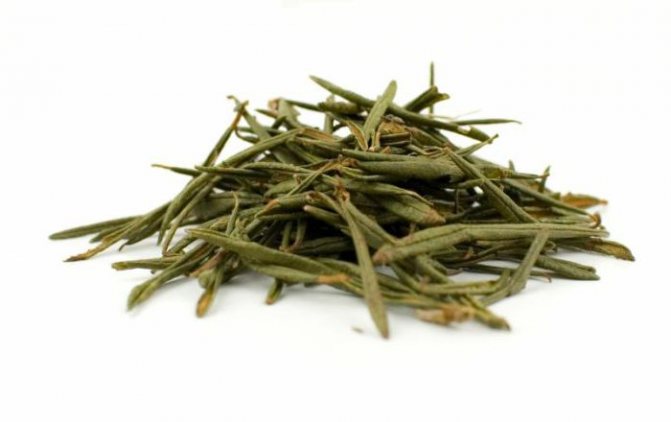

According to patients' reviews, it helps in the treatment of eczema and boils, frostbite and scabies, various eye diseases, rheumatism, arthritis and osteochondrosis, gout and other diseases.
Patients who used tinctures from shoots note that wild rosemary dilates blood vessels, improves blood circulation, and eliminates insomnia. The unique ability of the plant to reduce pressure has been revealed. Patients note the good tolerance of wild rosemary and the absence of toxic manifestations.
Recipes with wild rosemary and what ailments they help
An alternative to pharmacy medicines are folk recipes based on swamp. In this case, a person should be careful and study in detail the beneficial properties and contraindications for taking this plant.
The broth is considered the easiest to prepare and use. This requires 1 tsp. dry grass, which is filled with 1 tbsp. boiling water, bring to a boil and cook for 1-2 minutes. Immediately after this, the container is removed from the stove and left covered for about 30 minutes.After straining, the liquid is taken orally in 1 tbsp. l. This should be done after meals three times a day.
A decoction of wild rosemary is effective for coughs, colds, bronchitis, tuberculosis, angina pectoris. This medicine can also be used for inflammation in the intestines.
On the basis of such a liquid, you can prepare a medicine for the treatment of dermatological diseases. In this case, water with dry grass should be boiled not for 1-2 minutes, but until the amount of water is halved. After cooling and straining, an equal amount of vegetable oil is added to the liquid and the affected skin is treated with it.
For the treatment of gout, rheumatism, flu and eczema, rosemary infusion helps. To prepare it, 20 g of herbs are poured into 1 liter of boiling water and placed on the stove (or in the oven). The product should simmer over low heat (50 ° C) for 10 hours. After straining, the medicine is taken in ⅓ glass. It is important to do this after meals 3 or 4 times a day.
The water infusion has a low concentration of the plant and is used to treat coughs, tuberculosis, asthma, and diseases of the nervous system. For cooking, a cold method of infusion is used. For 1 tsp. herbs require 400 ml of boiled water. The liquid is infused for 10 hours and filtered. Such an aqueous infusion is taken 0.5 cups three times a day.
Tincture of wild rosemary on vodka or alcohol is recommended to be used inside with great care. It is mainly used for rubbing with sciatica and rheumatism. Lotions with alcoholic infusion are effective for gout. To prepare a liquid with alcohol, you must mix 1 part of dry herb and 5 parts of vodka or rubbing alcohol. The resulting mixture is placed in a glass container and insisted in a warm dark place for 24 hours.
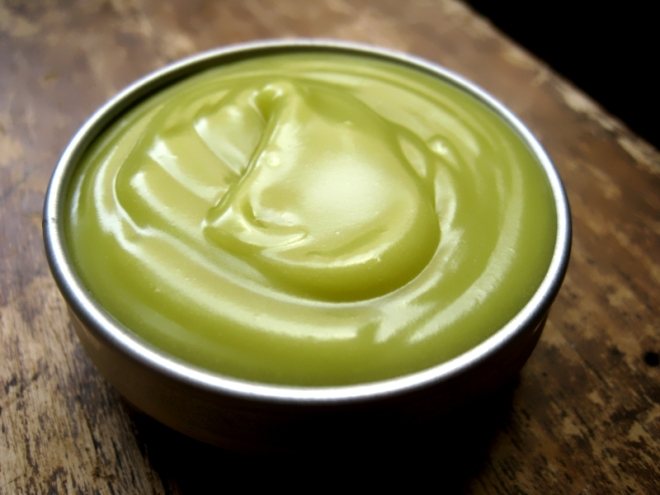

rosemary ointment is used for external use and has a powerful therapeutic effect
It will take several hours to prepare an ointment based on swamp, but the resulting product has no less therapeutic effect than pharmacy creams and ointments. Pork (or goose) fat and wild rosemary herb are alternately placed in a heat-resistant container. Layers are repeated until the container is full to the brim. After that, the cup is covered with a lid, and the edges are covered with dough.
The container is sent to the oven for 2-3 hours. During this time, the temperature must be maintained at 100 ° C. After that, the cup is taken out, the mixture is carefully filtered and cooled. You need to store the product in the refrigerator. After cooling, the mixture will acquire a semi-solid consistency. Apply the agent to sore spots 1-2 times a day.
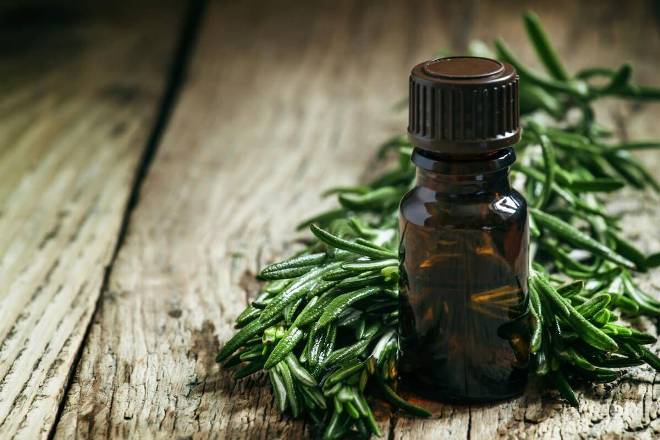

oil with rosemary has medicinal properties, it treats skin pathologies and takes good care of the skin
Rosemary oil can be prepared hot or cold. With a cold production technology, you need to take 2 tbsp. l. herbs and 4 tbsp. l. vegetable oil. The ingredients are mixed and kept warm for 12 hours. After straining, the product can be applied to the skin for eczema or other dermatological diseases.
With a hot cooking method, 3 tbsp. l. raw materials take the same amount of vegetable oil, mix and put in the oven for infusion.
Ledum honey. In shops you can find honey from the bog. This product has a dark brown color and a characteristic pungent odor. It is highly discouraged to consume such honey internally. Even a small amount, if ingested, causes headaches, nausea and dizziness. Most often, these beekeeping products are advised to be applied topically to eliminate pain in joints, treat skin diseases.
According to some recipes, wild rosemary honey is used in gynecology. To do this, a small amount of honey is applied to a cotton swab and injected into the vagina.
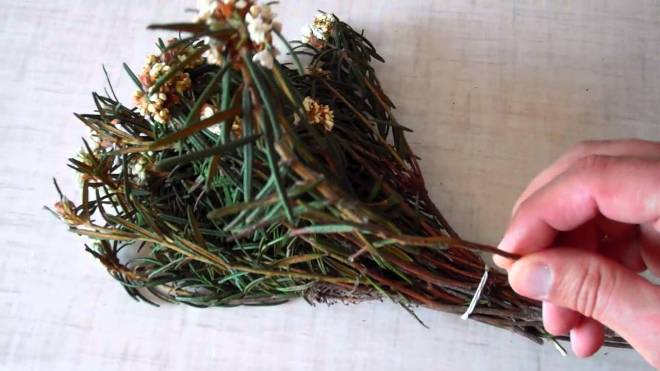

properly prepared raw materials have all the healing qualities of a fresh plant
Application
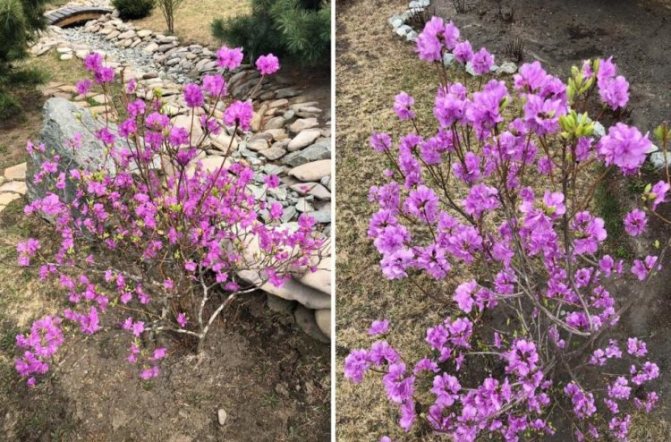

Medicines, which contain wild rosemary, increase the heart rate and suppress cough, and also dilate blood vessels (peripheral and coronary). In addition, wild rosemary acts as a good diuretic. However, the use of wild rosemary is not limited to medicine. It is used everywhere, both in everyday life and in cooking, and as a means for losing weight. You will learn more about this below.
In cooking
Ledum has a pronounced spicy aroma, and is often called forest rosemary. Actually, it is used in cooking in much the same way. Breads and flat cakes are prepared with wild rosemary, which slowly deteriorate due to the composition of wild rosemary, and also have a tonic effect. Jam is made with wild rosemary, and beer and vodka are often made from wild rosemary essential oils.
In medicine
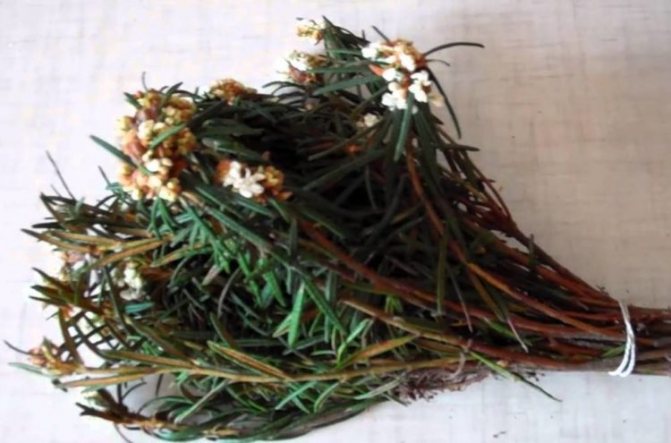

Ledum juice is used as a remedy for bacteria. It is able to fight viral diseases such as whooping cough or diphtheria, hemolytic streptococcus and luminous vibrio.
Rosemary essential oil is able to reduce cramps, relieve inflammation, accelerate blood flow and relieve spasms. Compresses for joints are made from wild rosemary, and are also used for neuritis and myositis. Decoctions or tinctures help fight headaches or diseases of the cardiovascular system, as well as asthma and bronchitis.
When losing weight
Since wild rosemary is a powerful diuretic, it is used in this way to get rid of a few extra pounds and remove excess water. However, in this case, the wild rosemary decoction works only to remove water from the body. In the future, wild rosemary can only aggravate the state of health.
At home
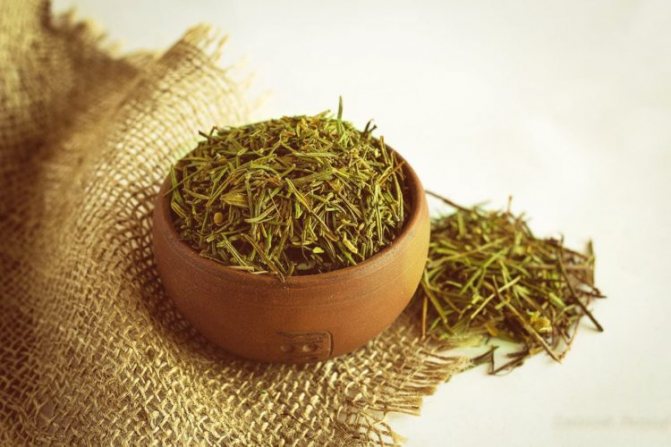

Ledum has a rich and spicy aroma that repels both insects and various rodents that are harmful to life. Dried wild rosemary herb will help solve problems with rats and mice, and will also be effective if mosquitoes and flies often appear in your house.
In cosmetology
Ledum is rich in various vitamins, so it can often be found in various creams and masks. The vitamins in the rosemary composition tone the skin and relieve puffiness, as well as nourish and cleanse. However, the independent use of wild rosemary in cosmetology will be dangerous, so it is better to simply purchase ready-made folk cosmetics created by specialists.
How the wild rosemary reproduces
In the wild, the plant reproduces successfully by seed. But, if you wanted to plant marsh rosemary in the garden or in the summer cottage, then preference should be given to the method of dividing or grafting.
- The seeds are in small boxes that hang from the stalks of the plant. They need to be sown in early spring in a prepared container filled with soil with sand. It is best to take the earth loose and sour. The container should be placed in a cool place. After 3 - 4 weeks, the first shoots will appear. After sowing, you need to regularly water the soil with rain or settled water.
- Reproduction by layering is the simplest method. Young thin shoots are tilted to the ground and sprinkled. Be sure to add peat for better rooting. Regular watering will allow the plant to develop quickly and correctly.
- The division of the bush is carried out in early spring. The shrub must be dug up and divided into independent parts, each of which must be planted in a separate hole. Then the plantings need to be covered with mulch with the addition of peat.
- Cutting requires additional skills, so it is not very common among gardeners. The procedure should be carried out in the summer. Semi-lignified stems are cut into pieces about 5 - 6 cm in size. The lower leaves are removed - only a few upper leaves need to be left. For more successful and quick rooting, it is first recommended to keep the cuttings in a special root-stimulating solution for about a day. Then they are planted in a prepared box or other container.
Important! The root system of the plant is located very close to the surface of the earth, so you need to loosen the soil carefully.
2. Varieties:
2.1 Swamp bog - Ledum palustre
A widespread evergreen shrub up to 1 m high. Stems are erect, abundantly branching. The leaves are narrow, tough, dark green in color. The surface of the leaves is glossy above, and may have pubescence below. When damaged, leaves and stems give off a pungent odor, as they contain a large amount of oils. Marsh rosemary resin was used to make incense. The flowers are collected in large fragrant umbrellas.
You may also be interested in:
- Euonymus - photo, description, planting and care, shrub varieties, soil for growing indoor plants, using an ornamental tree in landscape design, keeping at home
- Datura - a photo of a flower, a description of a plant. flowering time, reproduction - growing from seeds, planting and care in the open field and at home, what a poisonous plant looks like
- Periwinkle - photo, planting and care in the open field, description of the plant, useful properties, growing from seeds, planting seedlings in a flower bed, use in landscape design, home care
- Lemon - photo, home care, growing indoor lemon from seed, keeping the house - grafting, flowering, fruiting, description of varieties, diseases and pests, how to transplant a tree
- Immortelle - photo, medicinal properties of herbs and contraindications, collection and use of plants in folk medicine, description, planting and care in open ground, growing at home, reproduction
, on the menu
Growing areas
Most often, wild rosemary is found in swampy areas, on peat bogs. However, it is not easy to find a place where wild rosemary grows. Although it grows crowded, forming dense thickets, it is not easy to identify the territory of its accumulation: swampy sphagnum bogs surrounded by coniferous forests do not always allow you to find shrubs.
Siberia, tundra, middle zone of Russia - these are the areas of distribution of this plant. Prefers dark places without excessive sunlight.
Pharmaceuticals with rosemary
A number of plant-based preparations are presented in pharmacies:
- Shoots or wild rosemary herb. This product is presented in the form of raw materials (dry crushed grass). It is often used to treat cough in bronchopulmonary diseases.
- Ledin. The drug is produced in the form of tablets containing the essential oils of the plant. It is effective for acute and chronic laryngitis, bronchitis and tracheitis. Ledum for cough is used until symptoms are reduced.
- Fitopril. It is a multicomponent drug that acts as a beta blocker. It is often prescribed to prevent the development of angina pectoris, stroke, and arrhythmias.
- Ledum-GF. Ointment with homeopathic effect. The drug helps to eliminate pain in case of joint diseases, itching from mosquito and other insect bites.
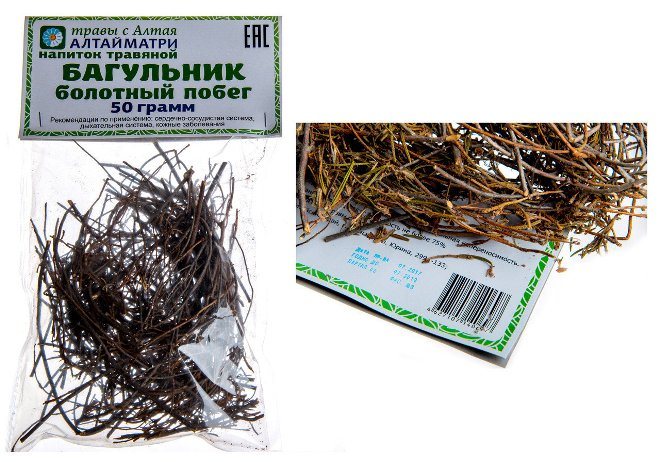

for the preparation of medicinal products, you can use independently prepared raw materials or purchased at a pharmacy
Botanical description
Marsh wild rosemary (Latin Ledum palustre, English Labrador Tea) is an erect evergreen shrub up to 150 cm high. Stems are recumbent, rooting, with numerous ascending branches. Shoots pubescent like felt. The bark of old branches is bare, grayish-brown. Ledum roots penetrate the soil in swamps to a depth of 40 cm.
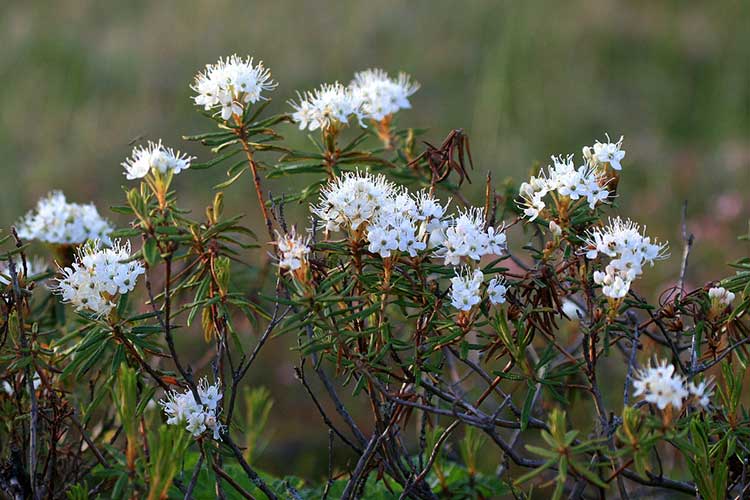

Marsh ledum (lat.Ledum palustre). Photo: Free nature images
The flowers are collected at the top in an umbrella-shaped scutellum, white or pink, with a strong aromatic stupefying odor that can cause headaches in calm and hot weather. The fruit is an oblong box with five valves, when ripe, cracking from the base and throwing out oblong seeds of a brownish-golden color.
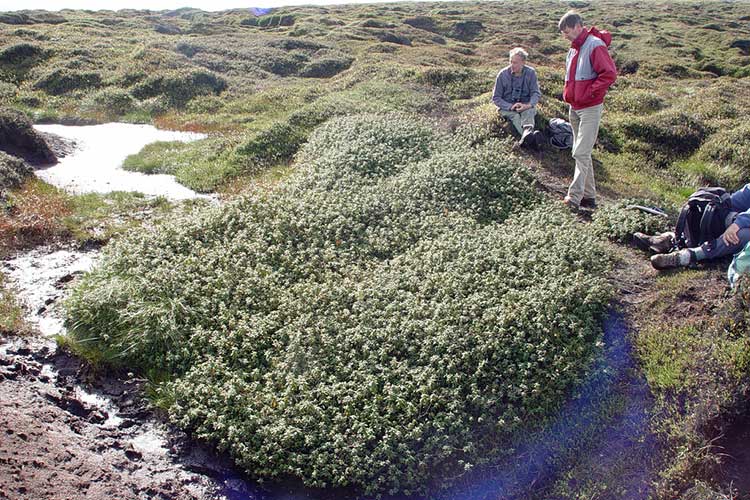

In the north, wild rosemary is not a deficit. Photo: Flora |
The herb of wild rosemary is collected during flowering, dried in the shade and stored in tightly closed vessels, as well as in boxes lined with waxed paper, well sealed (so that the essential oil does not penetrate).
Nutritional value and chemical composition
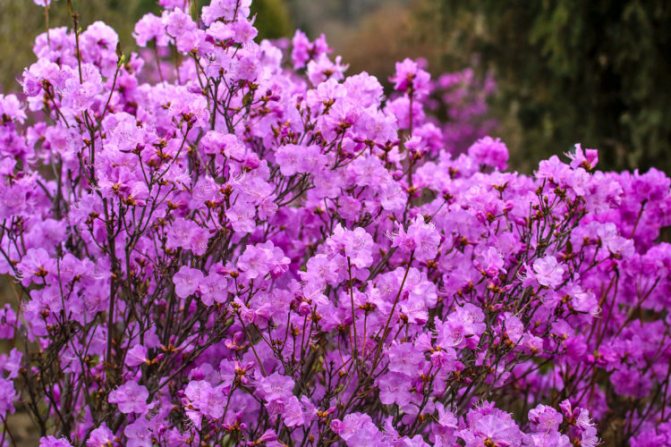

The rosemary contains:
- vitamin A;
- vitamin B;
- vitamin E;
- vitamin C;
- sodium;
- calcium;
- selenium;
- iron;
- silicon;
- zinc;
- manganese;
- cobalt;
- molybdenum;
- potassium;
- amino acids;
- organic acids;
- essential fatty acids;
- bioflavonoids;
- phytoncides.
Gallery: marsh rosemary (25 photos)
Ledum for the economy
This plant is used not only in medicine, but also in the household:
- Shrub twigs can be stored in a closet. This will prevent moths from forming.
- The pungent specific smell scares away mosquitoes, flies and other insects. For this purpose, the room is fumigated with a swamp or sprayed with a decoction of this plant.
- The bush ester is used in soap making and leather tanning.
- Previously, this raw material was used in brewing, but this alcoholic drink caused headaches and nausea.
Economic value and application [edit | edit code]
It is used in the perfumery industry.
The leafy shoots of wild rosemary have insecticidal properties, which is why they are sometimes used to fight insects.
Can be used for tanning leather.
Honey plant. Gives a small collection of honey, which is suitable for human consumption only after boiling [8].
When eaten by animals, the plant causes poisoning; it acts first in an exciting, then in a depressing manner. Poisoning is often accompanied by symptoms of gastroenteritis [9].
In medicine [edit | edit code]
Essential oil and ice cream have a bactericidal effect against Staphylococcus aureus. Ice-breaker is irritating and can cause inflammation of the gastrointestinal tract mucosa. It has been established that the preparations of marsh rosemary have expectorant properties. In an experiment on animals, blood vessels are dilated and blood pressure lowered [6].
Shoots of wild rosemary is sometimes used in the form of an infusion as an expectorant, antitussive for acute and chronic bronchitis and other lung diseases [7], as well as for spastic enterocolitis (inflammation of the small and large intestines). Eleopten (the liquid part of an essential oil), as well as a solution of essential oil in flaxseed oil, can be used to treat acute rhinitis and flu. [five] . Essential oil and juice from the leaves of wild rosemary have strong protistocidal properties [6]. It is also used as a diuretic, disinfectant and antiseptic. The preparation ledin is obtained from the essential oil.
In homeopathy, tincture with 60% alcohol [9] and rosemary leaves are used to treat rheumatic and gouty joint diseases.
In folk medicine, an infusion of wild rosemary herb is taken not only for diseases of the respiratory tract, but also as a diaphoretic, as well as for rheumatism, gout and eczema.
It must be remembered that marsh rosemary poisonous
... Its use is possible only as directed by a doctor [7].
A low flowering shrub with white flowers that grows in wetlands, peatlands and tundra throughout the Northern Hemisphere. The medicinal properties of wild rosemary have a fairly wide range of action on the human body. The plant is used in the form of various decoctions and infusions for a number of diseases.
Medical applications
Dosage forms of marsh rosemary are ointment, oil, decoction, tea, infusion and tincture on alcohol.
Ointment
Combine 3 tablespoons of finely chopped wild rosemary and 4 tablespoons of petroleum jelly and put in an oven heated to 40 degrees. Keep for 10-12 hours at this temperature, not allowing the mixture to boil. Filter and store in a cool place. Instead of petroleum jelly, you can take lard (internal pork fat).
If fresh grass is replaced with powdered dry shoots, then you can get an instant ointment. No heat treatment is required when using powder. The proportions are 1 part powder and 4 parts petroleum jelly. In addition to petroleum jelly, lanolin or lard is suitable as a base for ointment.
You can turn rosemary oil into ointment by mixing it with beeswax in a ratio of 1 part wax and 2 parts oil. The consistency can be adjusted as desired: the more wax, the harder the ointment.
The ointment relieves pain during exacerbation of arthritis, arthrosis and radiculitis.
Butter
Ingredients for cooking - dry shoots of wild rosemary and any vegetable oil. Pour raw materials into the container and pour oil so that the shoots are completely immersed in it.
The ideal way to obtain the oil is through moderate heating in a water bath or infusion. It is best to use dry herbs for the oil, as fresh grass contains moisture that can cause mold. You need to insist in the sun for 15 days, until the color of the oil changes. Then filter, pour into a dark glass bottle.
Procurement of raw materials
The collection of medicinal raw materials begins at the end of July and continues throughout August. When harvesting, gloves and a gauze bandage must be used. You should not stay near the bush for more than an hour and a half. Cut leafy shoots up to 10 cm long. After that, they are collected in small bunches, tied up and hung down with inflorescences. Drying is carried out in a well-ventilated area without access to sunlight. An attic is suitable for these purposes. And also the grass is dried in special dryers.
The air temperature can be from 10 to 55 degrees. The duration of air drying is two weeks, and the shelf life of raw materials is up to three years. You cannot use the living space for drying, the smell from the grass provokes vomiting, dizziness and nausea. Ready dry raw materials are placed in paper bags or cloth bags, and best of all - in glass jars with tight-fitting lids.
Benefit


It contains a large amount of complex essential oils, as well as various tannins, flavonoids and glycosides. Ledum is used as a pain reliever for problems such as rheumatism, arthritis, or gout. It is used to make tinctures and decoctions, as well as oil extracts for grinding.
A decoction of rosemary leaves has diaphoretic and diuretic properties. And tinctures from the leaves help with diseases of the upper respiratory tract, promote expectoration and soften the throat. Also, rosemary essential oils are able to deal with Staphylococcus aureus bacteria.
The grass of the marsh rosemary is often dried in order to mitigate attacks of bronchial asthma with the help of these dried flowers. Asthmatics are advised to keep a bag of dried wild rosemary herbs in their room to prevent asthma. The smoke from the burnt rosemary leaves acts as a good sedative.
Medicinal raw materials [edit | edit code]
Blank [edit | edit code]
Leafy young shoots with leaves and flowers are used as a medicinal raw material (the pharmaceutical name of the raw material is Latin Cormus Ledi palustris). Shoots are harvested during flowering [5]. Dry shoots in an open place in the shade, in a ventilated area or dryers at temperatures up to 40 ° C or in the shade under awnings. Dry raw materials have a characteristic pungent, resinous smell. Care must be taken when harvesting and drying it, as wild rosemary is poisonous.
Chemical composition [edit | edit code]
All parts of the plant, with the exception of the roots, contain an essential oil, in which up to 70% of sesquiterpene alcohols are bitter-burning taste and balsamic smell: in the leaves of the first year 1.5-7.5% and the second year - 0.25-1.4%; in the branches of the first year 0.17-1.5%, in the second year - from traces to 0.2%; in flowers - 2.3% and in fruits up to 0.17% [6]. Arbutin, tannins, flavonoids have also been found [7].
Application in traditional medicine
In alternative medicine, which draws on its centuries of experience, wild rosemary is used in the treatment of the following diseases.
Asthma
Disease of the respiratory tract, which is associated with increased sensitivity of the bronchi to various irritants. In asthma, the airways are narrowed and inflamed. This makes it difficult for air to move into and out of the lungs, causing coughing and shortness of breath.
Ledum preparations not only soften coughs, help to remove phlegm, but also relax the muscles around the airways. Inhalation of air saturated with vapors of rosemary essential oils relieves an asthma attack.
To treat asthma, you need to use an infusion of wild rosemary or a mixture of two herbs: nettle and wild rosemary, taken equally. Drink the prepared infusion (200 ml) during the day, in several doses.
Bronchitis
This is an inflammation of the bronchial walls caused by the activity of viruses. Ledum is good at liquefying phlegm, and its anti-inflammatory and antioxidant properties allow it to fight viruses.
Where and how it grows
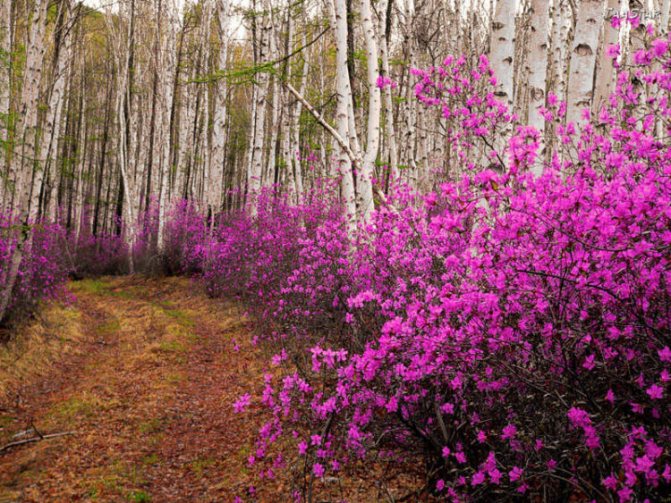

This wild plant is located in different territories. It grows in North America, the Far East and Greenland. It can also be found in Belarus in wooded peatlands. Ledum is often found in most of the Northern Hemisphere.
Ledum grows together with soil fungi. These mushrooms even stretch through the roots of the rosemary. When comparing wild rosemary with other plants, one significant plus can be distinguished. Ledum grows independently from seeds, and does not need the help of other plants or especially fertile soil.
Contraindications
Before using wild rosemary herb, you need to consult an experienced doctor and a clear dosage of the drug. In high doses, the plant is dangerous to human health. There are also some contraindications for use:
- pregnancy and breastfeeding;
- exacerbation of diseases of the digestive tract;
- pancreatitis;
- individual intolerance.
Since the plant has a strong effect, we do not recommend using it internally for children under 14 years old. Overdose can cause nausea, vomiting, and dizziness. If you experience the first symptoms of an overdose, immediately stop using the rosemary herb.

